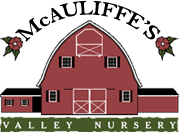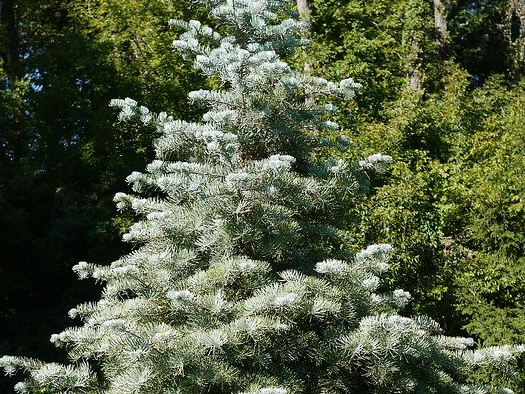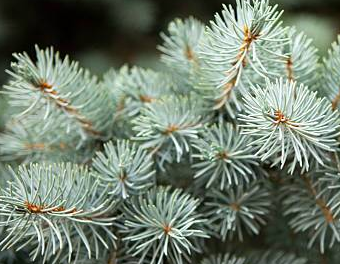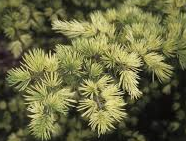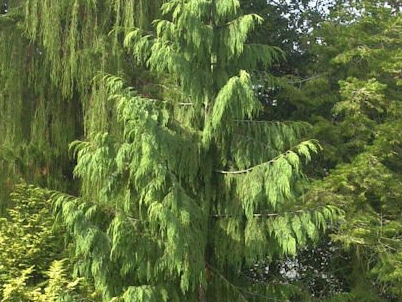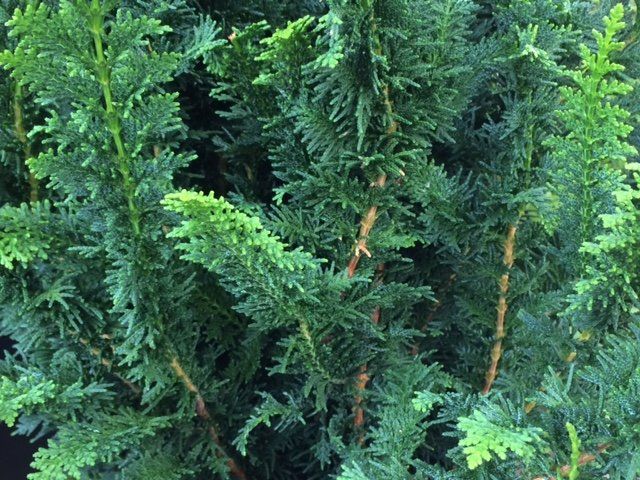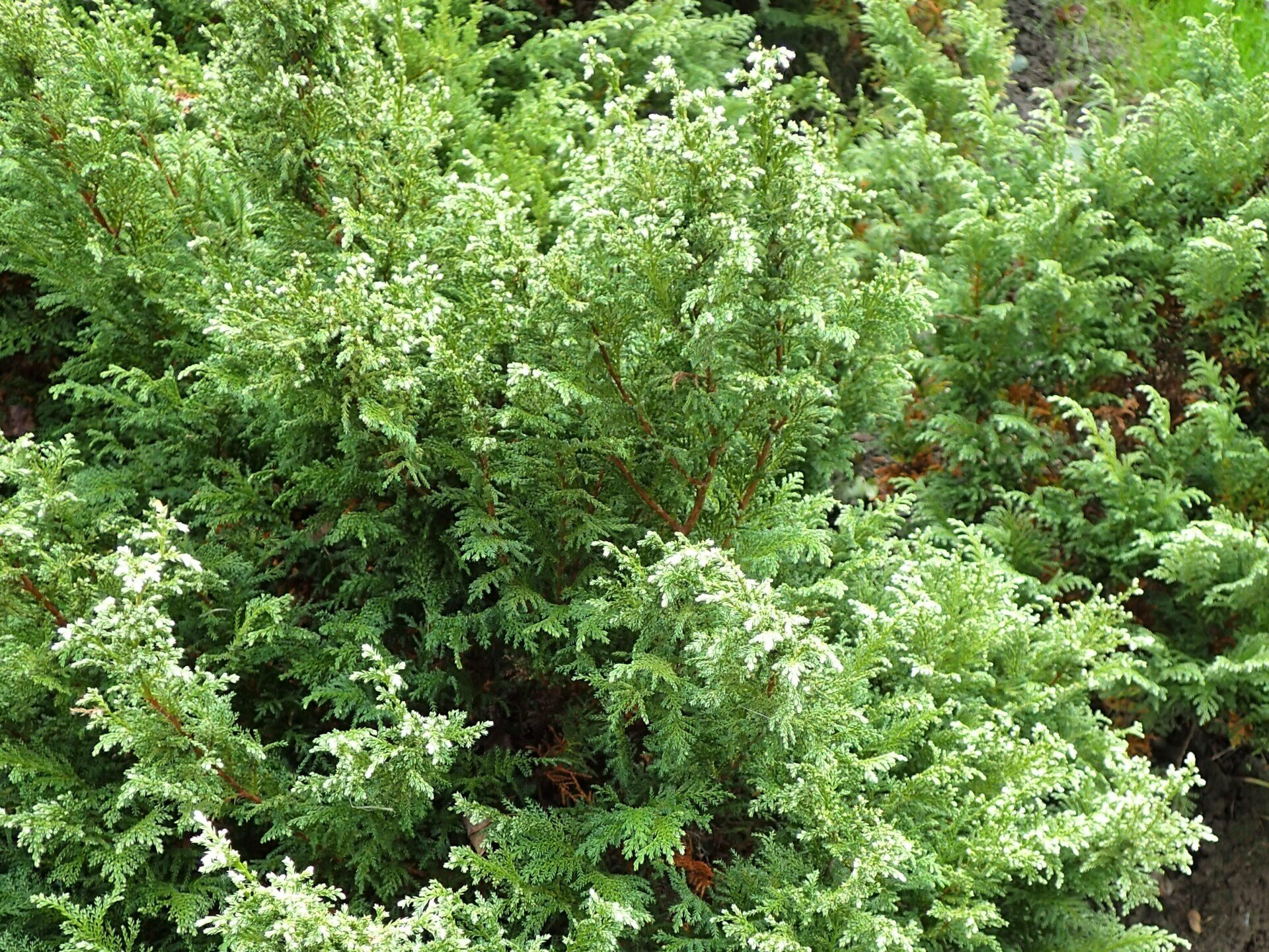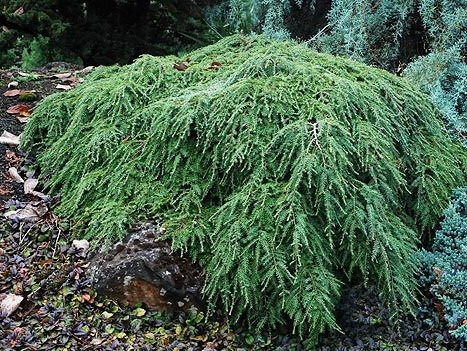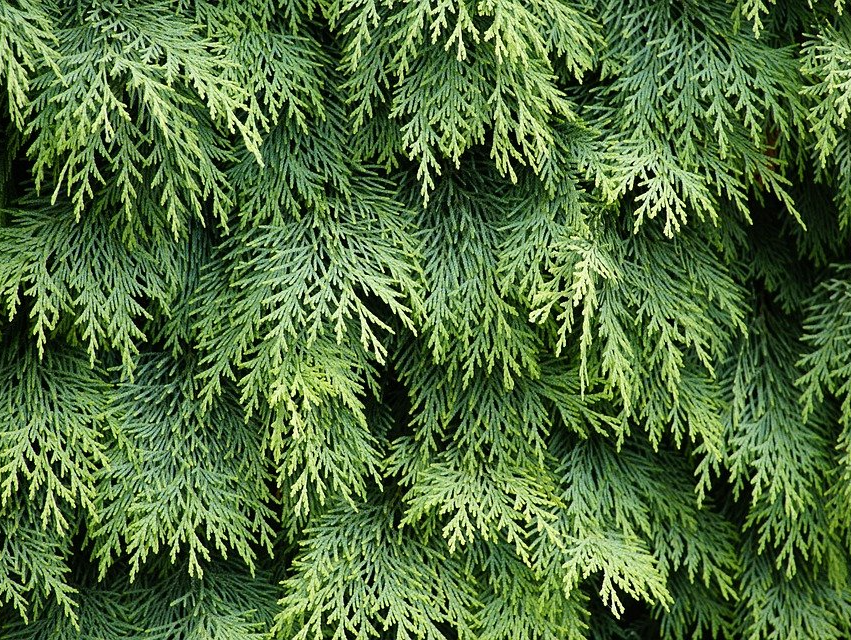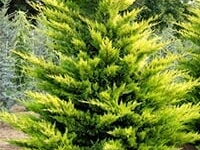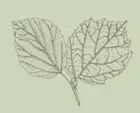CONIFERS
We are very proud of the varieties of conifers that we offer here at the nursery. Conifers are woody cone-bearing trees or shrubs. They can be deciduous, although most often we think of them as evergreen. With the increase in demand for low maintenance, drought tolerant options for our landscapes, there has been renewed enthusiasm for conifers. They offer year-rounded interest, unique colors, textures, and forms to the landscape. Many horticulturalists and plant breeders have worked over the years to develop a variety of sizes to suit the changing needs of gardeners.
We specialize in growing Emerald Green Arborvitae. Starting at 4–5' tall and going up, these columnar evergreen trees make an excellent privacy screen. As we grow these in our fields here in the valley, we are able to ensure the quality of our plants, provide large quantities, and keep the cost down. Call us or stop by for pricing and availability.
Conifers are now available in many sizes and are categorized as large, intermediate, dwarf, and miniature. The mature sizes are based on what can be achieved in ten years' time, although there may be regional and micro-climate differences.
Conifer Growth Rate per Year and Mature Size
- Large: 12" per year and 15' in ten years
- Intermediate: 6–12" per year and 6–15' in ten years
- Dwarf: 1–6" per year and 1–6' in ten years
- Miniature: 1" per year and 1' in ten years
This list represents plants that we commonly carry at the nursery. Please stop by the nursery or call us for current availability (360)862-1323.
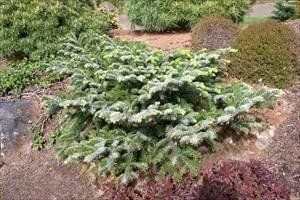
Abies amabalis
'Spreading Star'
Spreading Star Pacific Silver Fir
– A conifer enthusiast will find this low grower a wonderful garden addition. In the spring months, the new growth is light green which contrasts well with darker older needles. This spreading ground-cover-like dwarf conifer features a prostrate habit keeping it less than 3’ in height but perhaps up to 6’ in width after 10 years. Each year it may grow 4-8” in width. This plant needs full sun in a cooler climate, and partial shade where is warmer. Hardy in USDA zones 5-8.

Abies balsamea
'Nana'
Dwarf Balsam Fir
– With its dense and bright glossy green foliage Dwarf Balsam Fir does well in a moist garden. It would prefer the cooler regions of the Pacific Northwest. It often forms a flattened top which adds interest. They start out the season light green but darken as they age. It will perform best with supplemental irrigation during the summer during hot dry spells. This is a dwarf conifer that eventually grows to 3’ in both height and width forming a globose shape. prefers sun or partial shade. In hot conditions, it would benefit from protection from intense sunlight. Hardy in USDA zones 3-8.
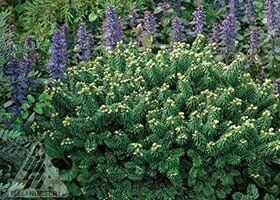
Abies balsamea
'Piccolo'
Dwarf Balsam Fir
– This dense, dwarf globe-shaped fir is smaller than the 'Nana'. It offers seasonal interest with its display of prominent brown buds on small dark green needles. It is the perfect selection for rock gardens, small landscapes, and containers. Thrives in sun to part shade. Hardy to USDA zone 3.

Abies concolor
'Candicans'
Abies concolor
– This striking dwarf conifer has powder blue needles. It has an upright habit and conical shape. Mature height is 7-10’ tall x 3-4’ wide in ten years. Prefers full sun. Hardy in USDA zone 4-8.
Abies concolor
‘Blue Cloak’
Blue Cloak White Fir
– This striking dwarf conifer has powder blue needles. It has an upright habit and conical shape. Mature height is 7-10’ tall x 3-4’ wide in ten years. Prefers full sun. Hardy in USDA zone 4-8.
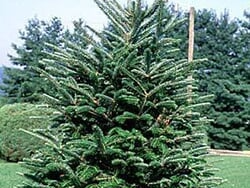
Abies fraseri
Fraser Fir
– Native to the Appalachian Mountains in the southeastern United States, evergreen tree with horizontal branches that are dense when young and more open with age with a fine to medium texture. This is a symmetrical pyramidal evergreen tree. Offering shining dark green color. Truly a beautiful Christmas or ornamental tree. Dislikes high pH and performs poorly in excessively hot and dry situations. Slow growth rate growing to 20 feet tall, over 20 years. Reaching 30' high and 25' wide. Prefers full sun. Hardy to USDA zone 4 A.
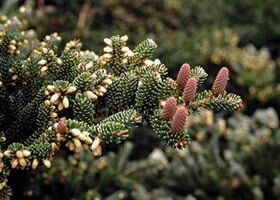
Abies koreana
Korean Fir
– This little conical-shaped conifer is a popular selection for those smaller ornamental garden landscapes. Its branches are layered and consist of tight, deep green needles that reveal a white underside. Providing seasonal interest, it bears upright, violet-blue cones in the Spring. Slow growing to 20' tall, 10-12' wide. Prefers full sun. Hardy in USDA zones 5-7.
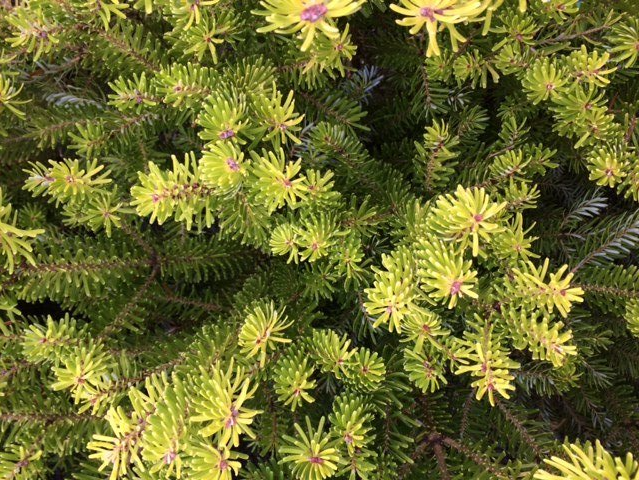
Abies koreana
'Aurea'
Golden Korean Fir
– The Golden Korean Fir is best known for its golden yellow foliage and purple cones. The new growth is a soft golden yellow, maturing to deep gold. The underside of the needles offers a pleasing green color. Cones are produced near the top whorl of branches. The stunning cones open pink before maturing to purple. This slow-growing ornamental conifer grows to 6’ after 10 years and eventually up to 20’ tall and only be 5’ in width. In areas west of the Cascades this species will do best in full sun. In hot conditions, it will benefit from partial shade. Hardy in USDA zones 5-8.

Abies koreana
'Cis'
Cis Korean Fir
– A miniature flat ball of dark glossy green foliage. Grows about one inch per year. Leaves are held flat to the stem with rounded ends. Very nice for rock gardens or trough plantings. Slow growing will reach 6" tall and 12" wide. Does best in full sun with well-drained soil. Hardy to USDA zone 5.
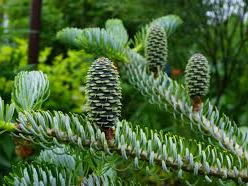
Abies koreana
'Silberlocke'
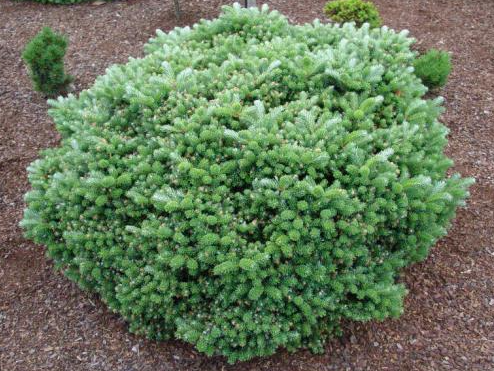
Abies koreana
'Silber Perl'
Silber Perl Korean Fir
– A tiny Korean Fir that grows only 1-2" per year, much wider than tall, short needles with silver undersides and buds that look like silver pearls in fall and winter. An exquisite garden gem. Does best with well-drained soil and should be protected from the harsh sun by planting in partial sun to part shade. Hardy to USDA zone 5.
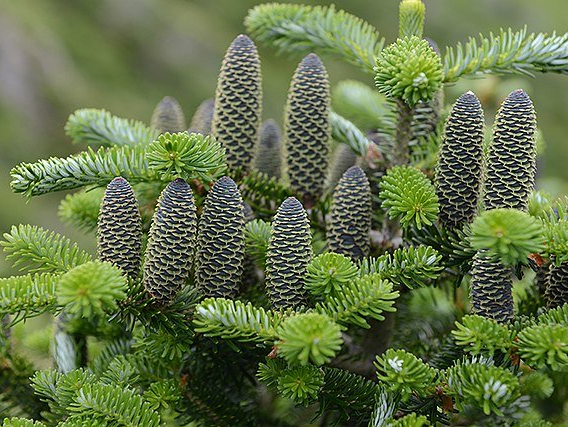
Abies koreana
'Starker's Dwarf'
Starker's Dwarf Korean Fir
– When young, this dwarf fir takes on a nest shape. Growing about 24" in a year, it takes on a mounded form as it matures to about 4-6' tall and 36" wide. The white underside of the dull, dark green needles provides a showy, bright contrast. Should be protected from the direct afternoon sun. Hardy to USDA zone 4.
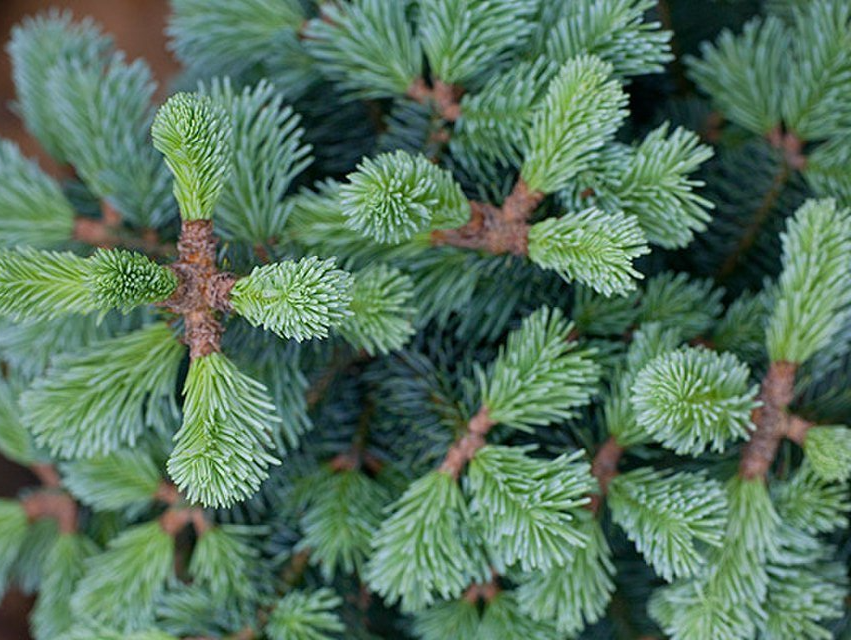
Abies lasiocarpa
Alpine Fir
– Beautiful classic conifer. Very narrow crown of dense foliage, branches are short and drooping to the ground. Leaves are grayish-green to light bluish-green, crowded, curving upward on upper twigs. Bears cones that are erect and barrel-shaped. Best if grown in a cool, moist situation in the Pacific Northwest. This is a very slow growing fir with a distinct habit. Very slender, erect, and rigid. Use as a specimen, in a rock garden or as a live Christmas tree. Matures at 40-100 feet tall and narrow. Prefers well-drained soil and the sun or partial shade. Hardy to USDA zone 5.
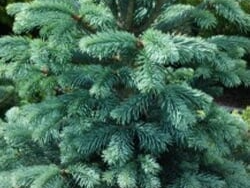
Abies lasiocarpa var. arizonica
Corkbark Fir
– Thick, corky creamy white branches give this tree its common name “Cork Bark”. Silver blue needles on this very handsome tree. Slow grower 4-6" per year reaching 6'-8' in 10 years. Well-drained soil and full sun. Hardy to USDA zone 4.

Abies lasiocarpa var. arizonica
'Compacta'
Dwarf Blue Arizona Corkbark Fir
– 'Compacta' is a low-growing evergreen conifer making a bushy medium-sized shrub with a broadly conical crown, bright blue-grey foliage, and purple young cones are produced occasionally by this cultivar. Grows best in moist but well-drained slightly acidic soil. Slow growing 6' tall, by 3' wide in 10 years. Reaching 10-15' tall, by 6-10' wide. Full Sun. Hardy to USDA zone 4.
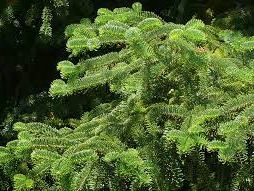
Abies nordmanniana
Nordmann Fir
– Commonly grown to be used for Christmas Trees because of its hardiness to the Northwest and its blunt needles this fir is a favorite in the landscape. It does well in poor drainage areas where Noble Fir and Douglas Fir tend to struggle. Matures to 40'-60' tall and 15'-20' wide. Full Sun. Hardy in USDA zone 4-7.
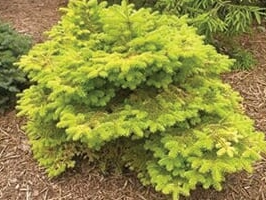
Abies nordmanniana
'Golden Spreader'
Golden Spreader Nordmann Fir
– The bright golden yellow of this low spreading fir is especially striking in winter when most of the gardens color has faded. Brightens areas with partial shade. Grows 3" per year reaching 3' tall with a 5' spread. Prefers part shade to full sun. Hardy to USDA zone 4.
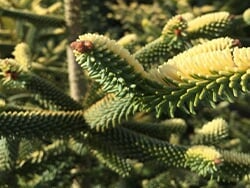
Abies pinsapo
'Aurea'
Golden Spanish Fir
– This form of Spanish Pin Fir is striking with its golden-yellow stiff needles. It is a very handsome conical tree. Young needles are yellowish, interesting red cones. Slow growing 4' in 10 years, reaching 25' at maturity. The golden color is best in full sun. Hardy to USDA zone 7.
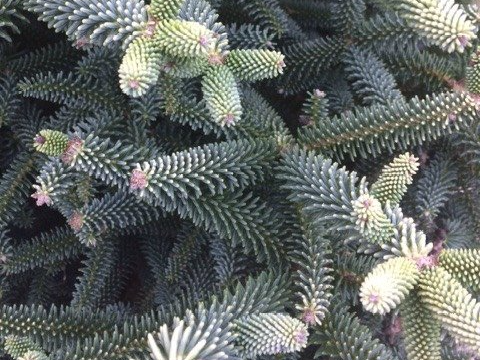
Abies pinsapo
'Glauca'
Blue Spanish Fir
– Slow growing has some of the most striking foliage of any conifer. It's frosty blue and waxy in appearance and more disease resistant than many other blue conifers and easy to grow. Best in full sun and drought resistant once established and likes acidic or alkaline soil as long it has good drainage. Will reach 15' in ten years maturing to 60' tall with 30' spread. Prefers full sun. Hardy in USDA zones 6 to 9.

Abies procera
'Glauca'
Blue Noble Fir
– A tall pyramidal tree, with eye-catching blue foliage. Will produce loads of large green cones. A nice specimen tree. It is initially slow-growing. After one or two years, once established, it starts to grow at a more vigorous rate. Grows 12" per year, reaching 40' tall. Prefers full sun. Hardy to USDA zone 5.
Abies x bormuelleriana
Turkish Fir
– This tree is rare in cultivation. A hybrid between a nordmanniana and cephalonica, which occurs in Turkey. Deer Resistant. An upright, majestic tree bearing long narrow cones. Will reach 30-50' tall, 30' wide. Prefers full sun but also tolerates some shade. Hardy to USDA zone 6.
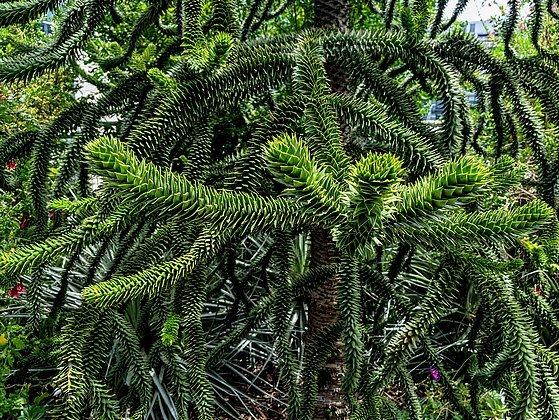
Araucaria araucana
Monkey Puzzle Tree
– It would "puzzle a monkey to climb this tree"- Unique and easily identifiable with a stiff, gaunt with an impressive growth habit. Ideal as a single specimen. Tolerant of many soil types, maritime exposures; and salt-laden winds, it thrives in cool, mild climates. Impressive "skyline trees". Slowly reaches 50' tall at maturity. Prefers full sun. Hardy to USDA zone 7.
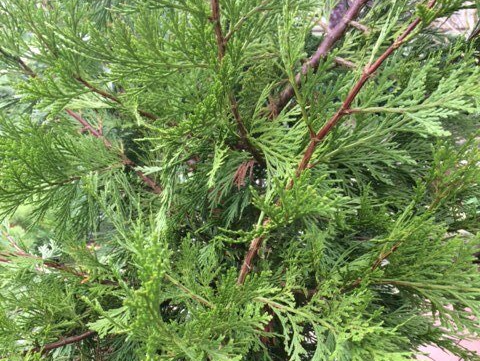
Calocedrus decurrens
Incense Cedar
– Easy to grow evergreen conifer native to the Pacific NW. The narrow upright form has a formal, stately appearance that only improves with age. Soft dark green foliage has a wonderful cedar fragrance. It is drought tolerant once established and is tolerant of poor soils, as long as it has good drainage, and tolerant of urban conditions. Upright and narrow reaching 15-18 feet tall and about 4-5 feet wide in 10 years maturing to 35-40 feet tall and 10-12 feet wide. Prefers full sun to light shade. Hardy to USDA zones 5-8.
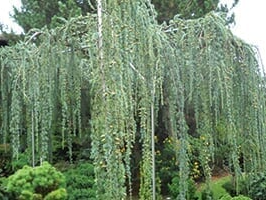
Cedrus atlantica
'Glauca Pendula'
Weeping Blue Atlas Cedar
– Conifer, evergreen, weeping branches with blue needles must be staked to develop a leader. Weeping form with blue-gray needles, the branches cascade like water over rocks, truly beautiful. When full-grown branches hang to the ground to form a curtain of foliage. Prefers moist, well-drained, deep loamy soil, but tolerates clay soils. Protect from sweeping winds. Prefers fun or partial shade. Hardy to USDA zone 6.
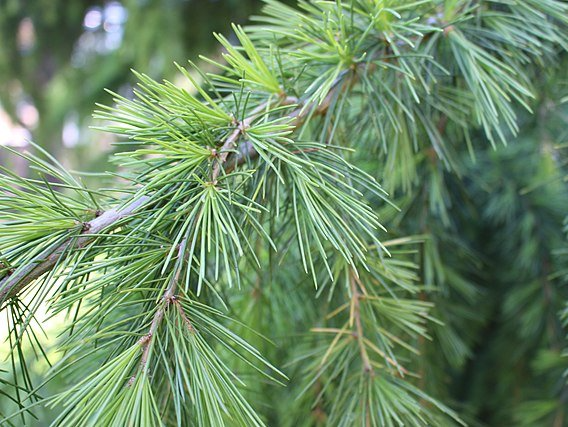
Cedrus deodara
Deodar Cedar
– Conifer, evergreen, broadly pyramidal with gracefully pendulous branches, drooping central leader, spreading and flat-topped with age. Long branches bearing spur-like stems with whorled needles. Leaves are light blue or grayish green and softer than C. atlantica. Prefers well-drained and somewhat dry soil. Protect from sweeping winds. Prefers full sun. Hardy to USDA zone 6.
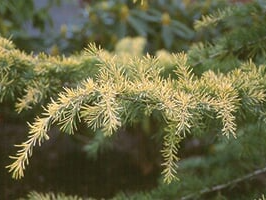
Cedrus deodara
'Aurea'
Golden Deodar Cedar
– Magnificent, graceful, pendulous habit. Golden yellow needles in the spring, greening in the fall, and greenish-yellow in winter. Grows up to 2' per year. Reaching 40'-50' after 30-40 years. Protect from sweeping winds. Best color in full sun. Prefers well-drained and somewhat dry soil. Hardy to USDA zone 6.

Cedrus deodara
'Feelin' Blue'
Feelin' Blue Deodar Cedar
– A dwarf conifer with lots of character, this little cedar adds natural interest to rock gardens and small spaces with its soft, blue-green needles and prostrate habit. This is a plant with versatility, it will grow in a mounding form if left alone or it can be staked upright to be allowed to droop and spread. A hardy cultivar as it is drought tolerant and pest free, it does prefer acidic, well-drained soils. Grows to about 3' tall and 6' wide. Prefers full sun. Hardy in USDA zones 6-9.
Cedrus deodara
'Girard Weeping'
Weeping Deodar Cedar
– This conifer is an elegant, weeping evergreen. An excellent alternative to Weeping Atlas Cedar. Will grow vertically or horizontally as it is very trainable. Can grow 3-15 feet tall or wide. Prefers full sun. Hardy to USDA zone 6.
Cedrus deodara
‘Gold Cascade’
Gold Cascade Weeping Cedar
– This dwarf conifer has light yellow needles on weeping branches. This graceful tree develops an upright habit and has a narrow shape. Prefers full to partial sun. Hardy to USDA zone 6.
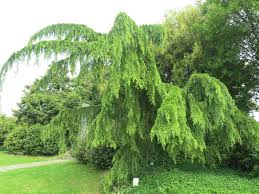
Cedrus deodara
‘Pendula’
Pendula Deodar Cedar
– This graceful weeping conifer has a rounded form. It has medium-long blue-green needles. Mature at 8’ tall x 12’ wide. Prefers full sun. Hardy to USDA zone 6.
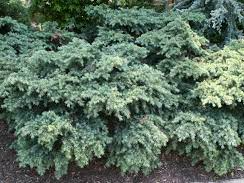
Cedrus deodara
'Prostrate Beauty'
Prostrate Beauty Deodar Cedar
– This unique beauty combines a spreading, horizontal habit with distinctive, blue foliage. The mid-size conifer is nearly flat when young but eventually develops a leader with age unless pruned to keep it low. New blue-green needles keep their soft, feathery look as they mature. Grows 6-8" per year, spreading to 6 feet wide. Prefers full sun. Hardy to USDA zone 7.
Cedrus deodara
‘Silver Mist’
Silver Mist Deodar Cedar
– Small beautiful dwarf cedar noted for its snow color foliage. A full pyramidal mound with soft light green- silver needles. 6' tall, 2-3 ' wide in 10 years. Good in full sun but can take some shade. Prefers full sun. Hardy to USDA zone 6.
Cedrus deodara
‘Snow Sprite’
Snow Sprite Deodar Cedar
– This graceful conifer has long creamy white – pale green needles on weeping limbs. Its habit is irregular and somewhat mounding. It matures at 10’ tall x 7’ wide. Prefers partial sun. Hardy to USDA zone 7.
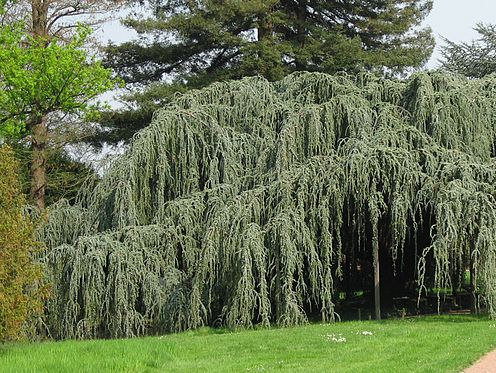
Cedrus libani
'Glauca Pendula'
Weeping Cedar of Lebanon
– This conifer is a handsome narrow upright form with sweeping pendulous branches. The hardiest of all the cedars. This is a great specimen tree. Prefers moist, well-draining soil. Slow growing, reaching 25' tall, and 9' wide. Prefers full sun. Hardy in USDA zones 5-7.
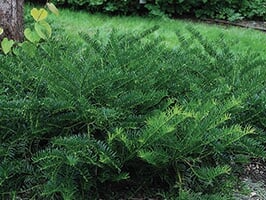
Cephalotaxus harringtonia
'Duke's Garden'
Duke's Garden Yew
– Conifer, evergreen shrub, wide-spreading, branches horizontal to partially ascending. Grows to possibly 4 feet high and 8 feet wide in 20 years. Leaves dark green, even in full sun. Prefers full sun to part shade. Hardy to USDA zone 5.
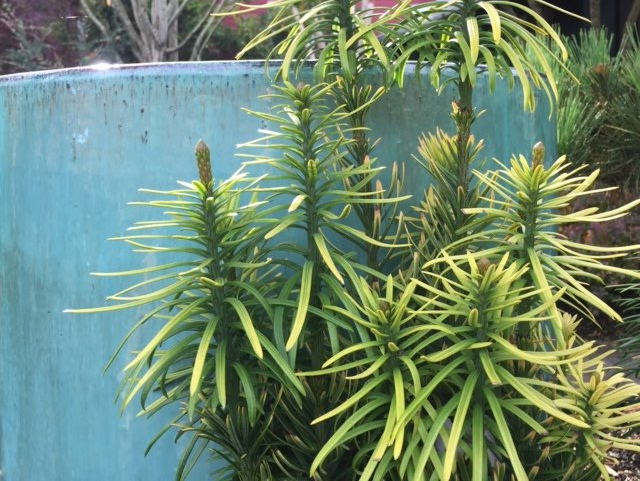
Cephalotaxus harringtonia
‘Korean Gold’
Korean Gold Yew
– New growth is gold-tipped and turns green as it matures. Narrow form. 5-8' wide x 2-3' wide. Part Shade. Hardy to USDA zone 5.
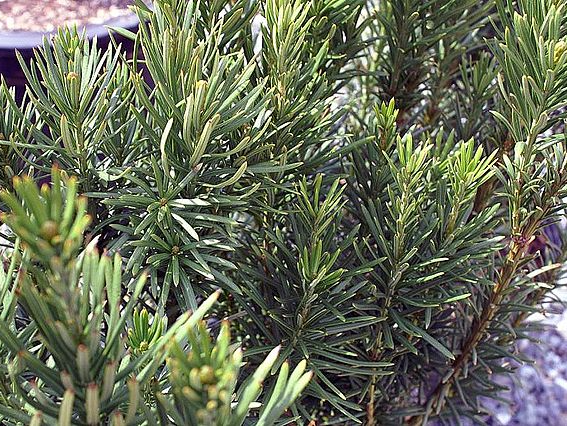
Cephalotaxus harringtonia
'Fastigiata'
Japanese Plum Yew
– Conifer, evergreen shrub, erect branches, columnar habit, Needles very dark green, spirally arranged, bowed, 3-5 cm long, sharp pointed. Grows to 10 feet tall and 7 feet wide. Prefer part to full shade. Hardy to USDA zone 5.
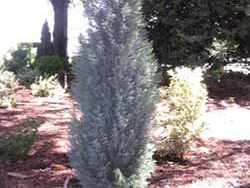
Chamaecyparis lawsoniana
'Blue Surprise'
Blue Surprise Lawson Cypress
– The steel-blue foliage on this dwarf conifer makes it stand out whether it's in the landscape or in a container. Its dense, upright, tight habit makes it suitable for small spaces. Grows up to 6' tall and 1.5' wide. Prefers full sun. Hardy to USDA zones 5-9.
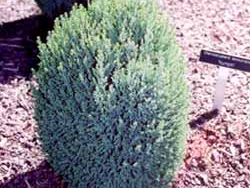
Chamaecyparis lawsoniana
'Nymph'
Nymph Lawson Cypress
– A dwarf, slow-growing rounded conifer with blue-green foliage. Great for containers, alpine gardens and any narrow or small spaces in the landscape. Only grows an inch per year, maturing at 3 feet. Prefers full Sun. Hardy in USDA zones 5-9.
Chamaecyparis lawsoniana
‘Ellwoodii’
Ellwoodii Lawson Cypress
– A densely conical form with upright feathery branches of blue-gray leaves. Matures at 15’ tall x 5’ wide. Prefers full sun. Hardy in USDA zones 6-10.

Chamaecyparis lawsoniana
‘Snow White’
Snow White Lawson Cypress
– Soft, needle-like evergreen foliage emerges creamy white in spring, maturing to blue-green. Matures at 5-6’ tall and wide. Prefers partial to full sun. Hardy in USDA zones 6-9.
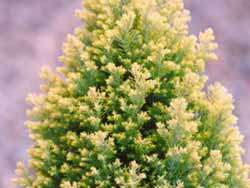
Chamaecyparis lawsoniana
'Treasure Island'
Treasure Island Lawson Cypress
– Conifer, compact, very dwarf, miniature round ball of juvenile yellow leaves. Great plant for containers, bonsai or in rock gardens. Grows about 1/2" per year, maturing at about 18" tall. Partial shade will burn in sun. Hardy to USDA zone 5.

Chamaecyparis lawsoniana
'Wissel's Saguaro'
Wissel's Saguaro Lawson Cypress
– A fun, upright conifer with deep blue-green foliage. A fantastic specimen for any landscape, gaining its name by the way its trunk and branches twist and grow, replicating the arms of a Saguaro cactus. Grows to 6' tall and 2' wide in 10-year span. Prefers full sun. Hardy to USDA zone 5.
Chamaecyparis nootkatensis
'Pendula'
Weeping Alaska Cedar
– A native evergreen forms an outstanding sculptural specimen. Rich green foliage hangs like curtains from its branches creating a stately and graceful accent in the landscape. Grows best in full sun with well-drained soil and is drought tolerant once established. Slow growing evergreen reaching 10-15 feet tall and 8 feet wide in 10 years maturing around 20-35 feet tall and 10 feet wide. Hardy to USDA zones 4-8.

Chamaecyparis nootkatensis
'Van Den Akker'
Narrow Alaskan Yellow Cedar
– This cultivar of Alaskan yellow cedar is quite possibly the narrowest form brought into cultivation to date. With a very pillar-like habit, it is described as even more columnar than Chamaecyparis nootkatensis
‘Green Arrow‘. The gently weeping branches grow to a width of under 1 foot for the first ten years. Extremely useful for small gardens or tight spaces, it provides welcome height without growing too wide. Its unique form is perfect for focal point plantings and adding structure to the garden. It adapts to a variety of soils provided there is good drainage. Once established it is very drought tolerant, requiring little to no summer watering even during prolonged droughts. Each specimen is unique. Growing 20-30' tall, variable width, staying narrow. Grows best in full sun but will tolerate part shade. Hardy to USDA zones 5-8.
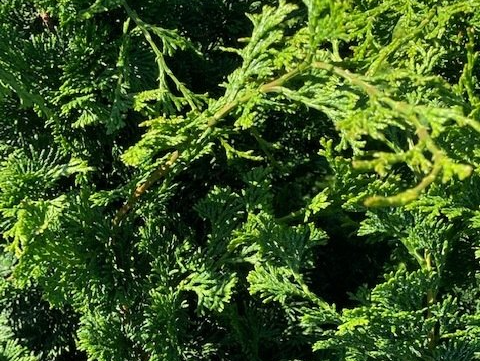
Chamaecyparis obtusa
Hinoki Cypress
– Conifer, evergreen tree, slow-growing, conical, more compact than species; branches outspread; branchlets slender, arching, irregularly arranged. Leaves short, dense, closely pressed, of two sizes, the lateral pair much larger than facial leaves, glossy dark green above, light green below. Hardy to USDA zone 4.
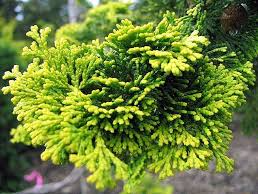
Chamaecyparis obtusa
'Aurea'
Golden Hinoki Cypress
– A vigorous, dependable conifer that lends year round beauty to the landscape. Irregular branching gives each tree a unique, natural character. The outer foliage of 'Aurea' is golden and the inner is green. Growth can be slow. Reaching 15 feet tall by 10 feet wide. Prefers partial shade. Hardy in USDA zones 4-8.
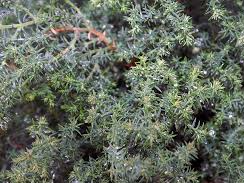
Chamaecyparis obtusa
‘Blue Feathers’
Blue Feathers Hinoki Cypress
– Offers soft juvenile foliage in an upward twisting growth habit. Also known as Ivan’s Column Hinoki False Cypress. Matures at 12’ tall x 4’ wide. Prefers full sun. Hardy in USDA zones 5-8.
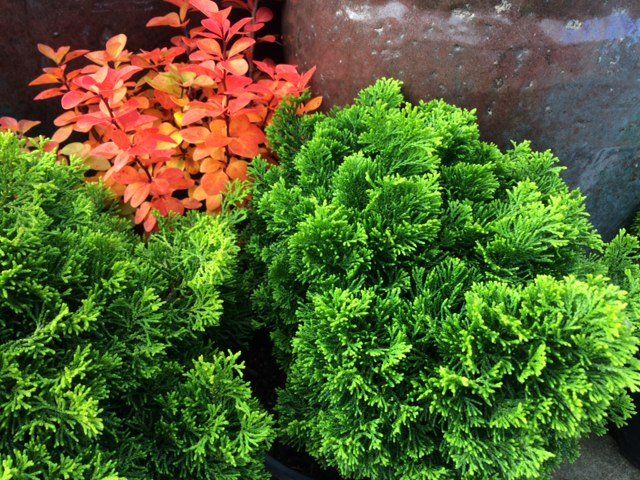
Chamaecyparis obtusa
‘Butterball’
Butterball Hinoki Cypress
– Bright, lemony yellow tips on tightly congested foliage give this small, globose Hinoki a fresh, cheery look. A consistently rounded habit and a very slow growth rate. 1' x 2'. Full Sun. Hardy to USDA zone 5.
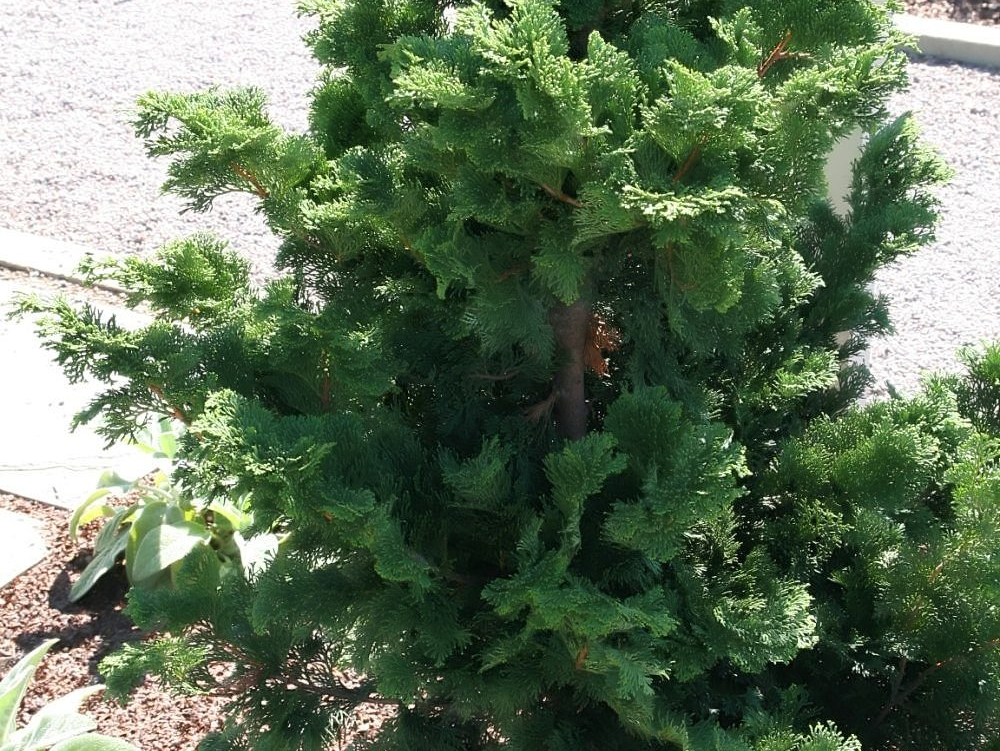
Chamaecyparis obtusa
'Compacta'
Compact Hinoki Cypress
– This is a semi-dwarf conifer variety that has the advantage of looking like a mature specimen with a dwarf form. Outstanding rich dark green color. Reaches 10 feet tall in 10 years, fairly fast-growing reaching up to 25 feet tall. Prefers full sun to bright shade. Hardy to USDA zone 5.
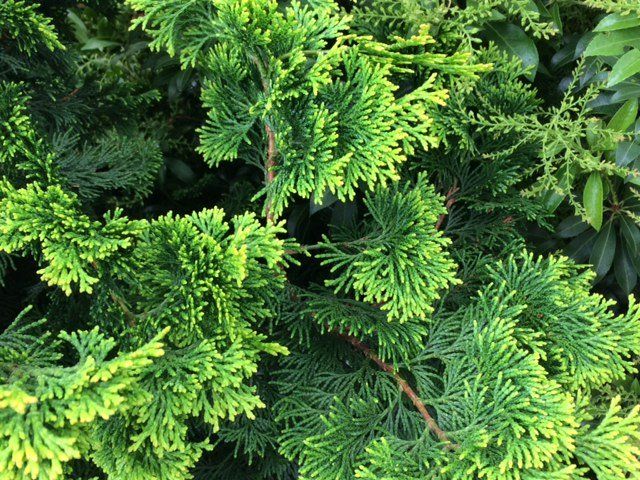
Chamaecyparis obtusa
‘Confucius’
Confucius Hinoki Cypress
– Beautiful golden-yellow Hinoki with feather-like foliage appearing 2-tone in texture. Can reach 15' tall by 8' spread after many years. Full sun to part shade. Hardy to USDA zone 5-8.
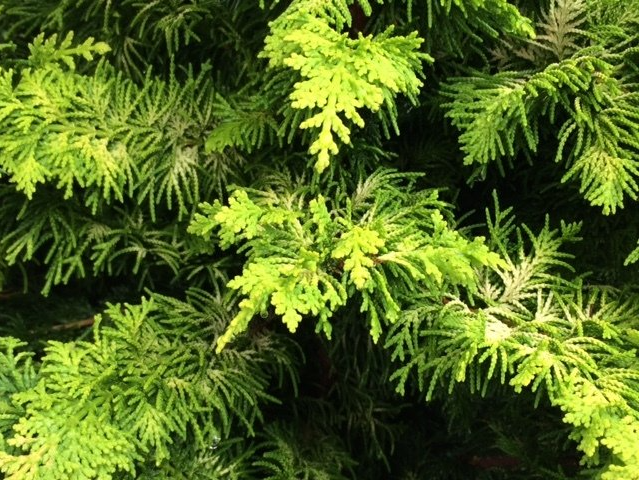
Chamaecyparis obtusa
'Fernspray Gold'
Fernspray Gold Hinoki Cypress
– Very suitable for smaller landscapes, this moderate-sized, upright conifer with arching branches of golden, feathery fern-like foliage. May get an orange hue in winter. Grows slowly up to 10' tall and 5' wide. Prefers well-drained soil and heavily mulched roots to keep moist and cool. In full sun it will produce the brightest gold color, avoid planting in the direct full sun as foliage can burn. Hardy in USDA zones 4-8.
Chamaecyparis obtusa
‘Filicoides Compacta’
Filicoides Compacta Hinoki Cypress
– Handsome pyramidal form, with graceful curved limbs with unusual fern-like foliage. Adds interesting texture to the garden. Excellent in entry-ways or large planters. Slow grower to 8' tall, 3-4' wide in ten years. Full Sun/ Lt. shade. Hardy to USDA zone 5.

Chamaecyparis obtusa
‘Gemstone’
Gemstone Hinoki Cypress
– It has tightly layered green fans of darker and lighter shades. It has an irregular conical shape. Prefers partial to full sun. Matures at 2’ tall x 1.5’ wide. Hardy to USDA zone 5.
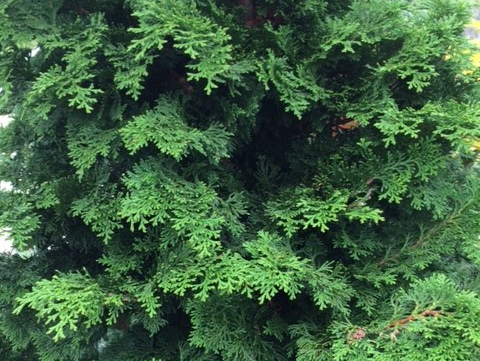
Chamaecyparis obtusa
'Gracilis'
Slender Hinoki Cypress
– A must-have for the garden. Its twisted, deep green branchlets are held on tiered branches, creating an open habit. They thrive in well-drained, humus-rich soil in bright shade. It matures at 15 feet tall and only 6 feet wide. They can be grown in full sun with careful attention to watering in the summer and is drought tolerant in part shade. In warmer regions provide protection from hot afternoon sun. Hardy in USDA zones 4-8.
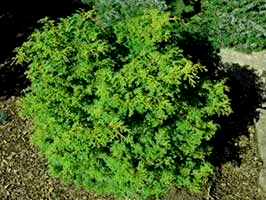
Chamaecyparis obtusa
'Kosteri'
Kosteri Hinoki Cypress
– No garden should be without a dwarf Hinoki cypress. This is a beautiful conifer, slow-growing and columnar to pyramidal in habit with glossy dark green foliage that twists creating a sumptuous texture, and is an excellent choice for a container. They thrive in well-drained, humus-rich soil in bright shade. Can be grown in full sun with careful attention to watering during summer, drought tolerant in part shade. In the warmer parts of our region, provide protection from hot afternoon sun. This evergreen coniferous shrub grows slowly to 4 feet tall and 5 feet wide with an open habit of ascending branches that are somewhat shell-shaped. Hardy in USDA zones 4-8.
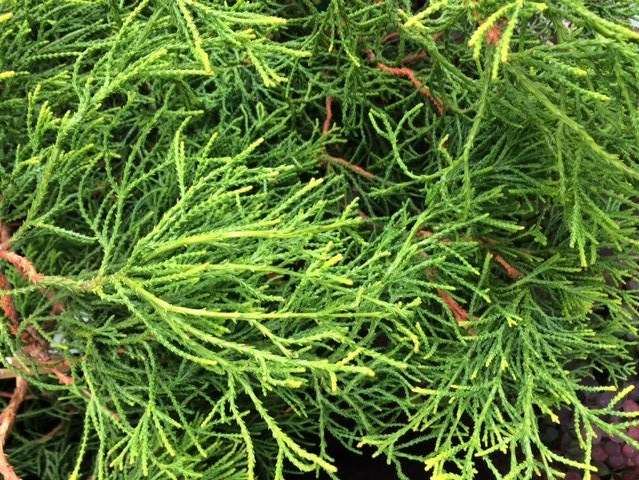
Chamaecyparis obtusa
'Lemon Twist'
Lemon Twist Hinoki Cypress
– An unusually shaped dwarf conifer, the zesty, bright yellow foliage stands out on the reddish bark. The open mounding form will get 5-6' and grow as wide as it does tall. Plant in well-draining soil in an area where it will be protected in the afternoon sun during the hot summer months. Hardy to USDA zone 5.
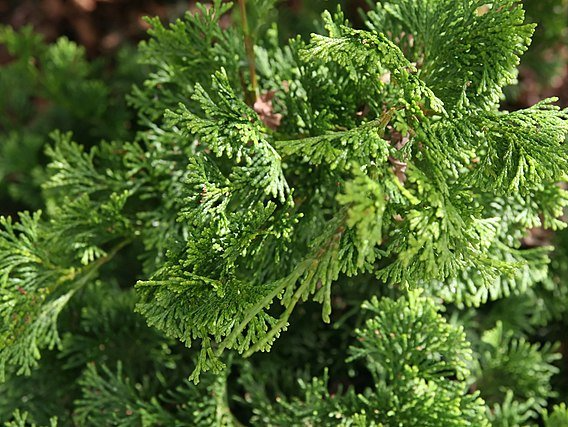
Chamaecyparis obtusa
‘Nana’
Nana Hinoki Cypress
– The branching habit of this dwarf conifer is unique, with its dark green flattened leaves that twist into small overlapping fans, forming what looks like a small green cups. Matures at 2 feet tall and 3’ wide. Prefers full sun. Hardy in USDA zones 4-8.
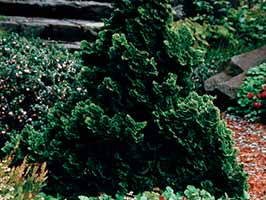
Chamaecyparis obtusa
'Nana Gracilis'
Nana Gracilis Dwarf Hinoki Cypress
– This is a beautiful conifer, intermediate growth, and columnar to pyramidal in habit with glossy dark green foliage that twists creating a sumptuous texture in a tightly conical shape, and is an excellent choice for a container. They thrive in well-drained, humus-rich soil in bright shade. Can be grown in full sun with careful attention to watering during summer, drought tolerant in part shade. In the warmer parts of our region, provide protection from hot afternoon sun. This evergreen coniferous shrub grows slowly to 2 feet tall in 10 years maturing to 8 feet tall. Hardy in USDA zones 4-8.

Chamaecyparis obtusa
'Nana Lutea'
Nana Lutea
– One of the many different types of Hinoki false-cypress. This particular variant features yellow highlights on golden-green foliage in flattened sprays. A beautiful dwarf conifer, with dense foliage. Adds interesting color and texture to the landscape. Prefers semi-moist well-draining acidic soil. Protect from hot afternoon sun, the foliage will burn if this species is planted in too much sun, Prefers bright shade. Slow growing in a pyramidal shape at 3-6" per year, reaching 3-5 feet tall in 10 yrs. Hardy in USDA zones 5-8.
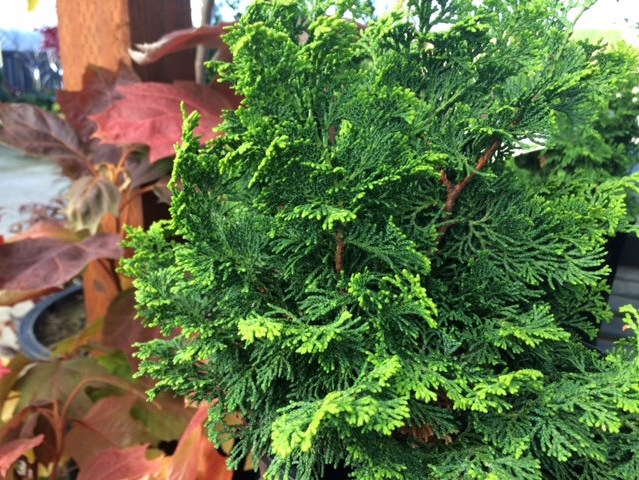
Chamaecyparis obtusa
‘Rainbow’
Rainbow Hinoki Cypress
– A miniature evergreen conifer with an irregular upright form. Foliage is yellow in spring and summer and then turns to bronze-gold in winter. Prefers partial to full sun. 12" tall x 10" wide. Hardy to USDA zone 5.
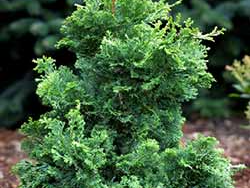
Chamaecyparis obtusa
'Split Rock'
Split Rock Hinoki
– An upright, narrow coniferous tree with dark green, flattened sprays of scale-like, overlapping leaves and blue juvenile foliage. Very slow growing developing a pyramidal shape. Grows best in moist, fertile soil in full sun. This dwarf Hinoki cypress will tolerate slightly alkaline soils but prefers neutral to slightly acidic soil and does not need pruning. It grows only 6 to 8 inches a year, reaching a ten-year height of 5 to 6 feet. Hardy in USDA zones 4-8.
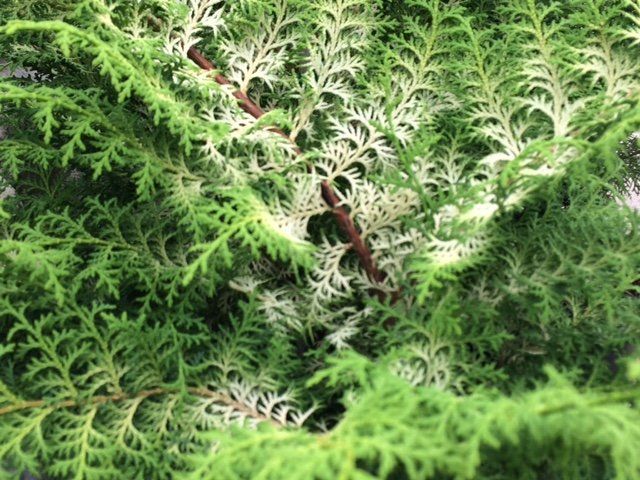
Chamaecyparis obtusa
‘Sunlight Lace’
Sunlight Lace Hinoki Cypress
– Bright lemon yellow foliage adorns this light airy tree with a texture reminiscent of fine lace. Matures at 15’ tall x 12’ wide. Prefers morning sun and afternoon protection. Hardy to USDA zone 5.
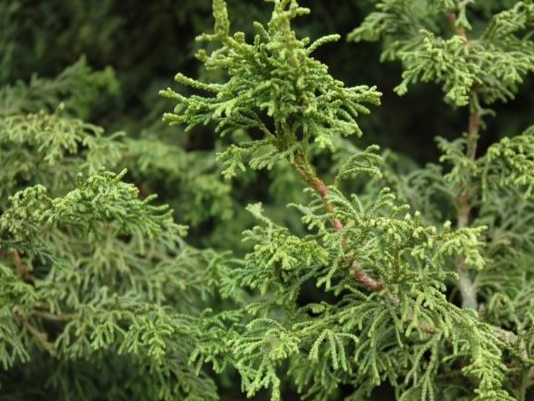
Chamaecyparis obtusa
'Torulosa'
Twisted Hinoki Cypress
– Unique twisted and contorted branches with dark green yarn-like foliage. Slow-growing reaches 6 feet tall by 4 feet wide in a 10 year period. This is a nice choice for a container. Prefers full sun to part shade. Hardy to USDA hardiness zone 5.
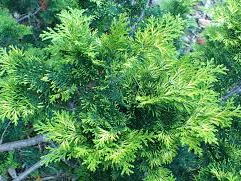
Chamaecyparis obtusa
'Verdoni'
Verdon Hinoki Cypress
– This variety is compact, upright, and golden, all desirable traits. To make it even more coveted it will not burn in full sun. A dependable golden yellow Hinoki selection. Grows 3-6" per year, reaching 10 feet tall and 4 feet wide. Prefers sun to part shade. Hardy in USDA zones 4-8.
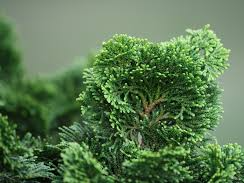
Chamaecyparis obtusa
‘Well’s Special’
Well’s Special Hinoki Cypress
– Slow growing, conical tree. Dressed in outspread branches, with slender branchlets that arch, irregularly arranged. Rich, dark, fan-like leaves. Expected growth is 6" per yr. Full Sun/Lt. Shade. Hardy in USDA zones 4-8.
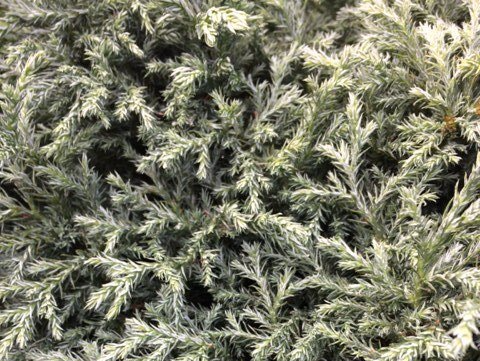
Chamaecyparis obtusa
'Baby Blue'
Baby Blue Cypress
– An upright, dwarf, a finely textured conifer with beautiful, soft, bright silvery blue-green foliage that is open and airy. Offering year-round interest this cypress has a purplish hue in the winter. Great for small gardens. areas, containers, or it can be pruned for maintaining a hedge. Will grow no taller than 6' and 4' wide and is not as vigorous a grower as 'Boulevard'. Avoid planting in water-logged areas. Hardy to USDA zone 5.
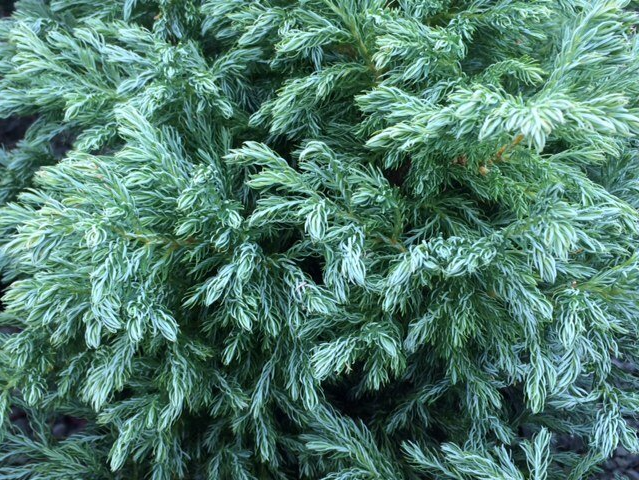
Chamaecyparis pisifera
'Boulevard'
Boulevard Cypress
– A dense, pyramidal semi-dwarf evergreen shrub that features soft silvery blue-gray foliage. Prefers moist, well-drained soil; protect from strong wind. Slow growing typically reaching 5-6 feet tall in 10 years matures at 10-12 feet tall and 3 feet wide. Prefers the sun to part shade. Hardy in USDA zones 4-8.
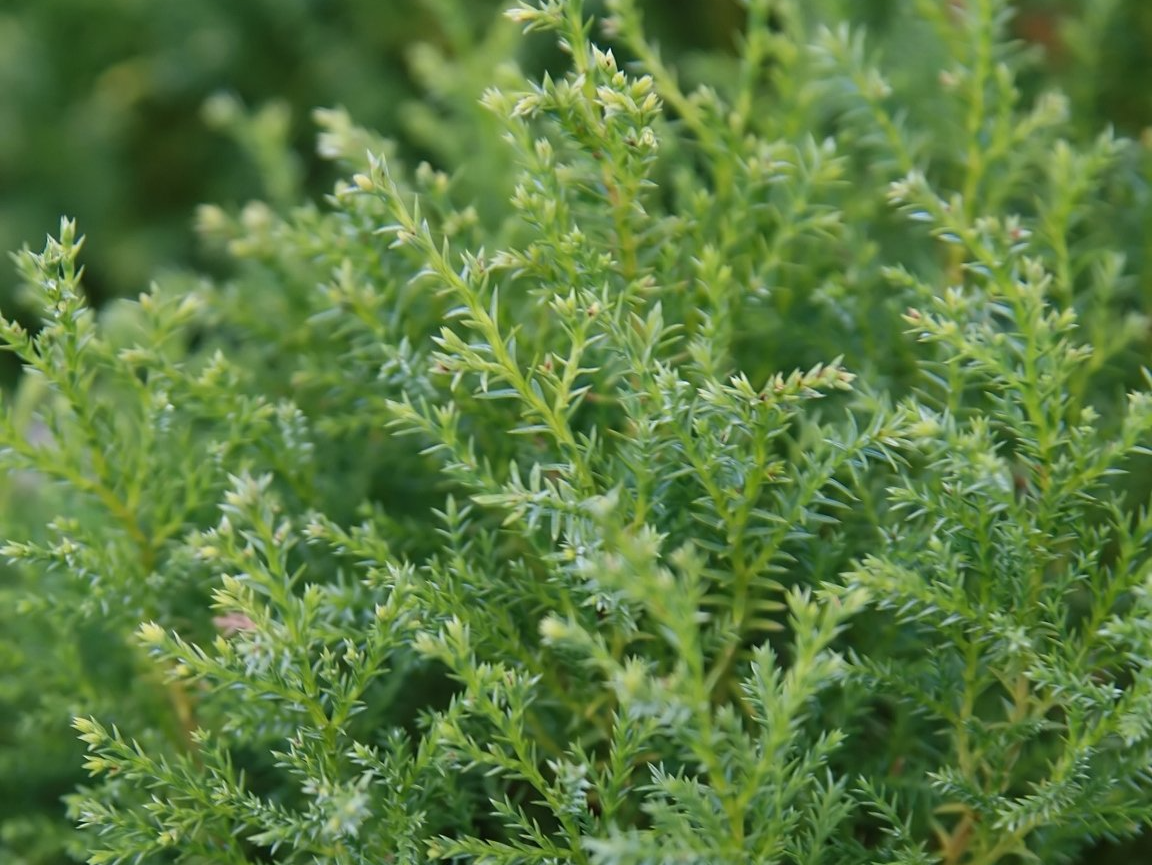
Chamaecyparis pisifera
'Cream Ball'
Cream Ball Cypress
– A dwarf, rounded conifer. Green foliage with creamy white tips. Soft texture, globe shape. Prefers a moist, well-drained soil with good air circulation. Slow growing to 3 feet tall and wide. Prefers full sun to part shade. Hardy to USDA zone 5.
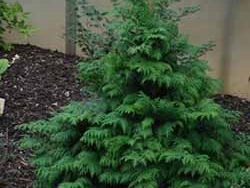
Chamaecyparis pisifera
'Dow Whiting'
Soft Serve False Cypress
– A slow growing columnar evergreen. Deer resistant- Great in a container or as a soft hedge or screen planting. Requires regular watering. Slow-growing up to 6-10' tall and 5-6' wide. Prefers full to part sun. Hardy in USDA zones 5-7.
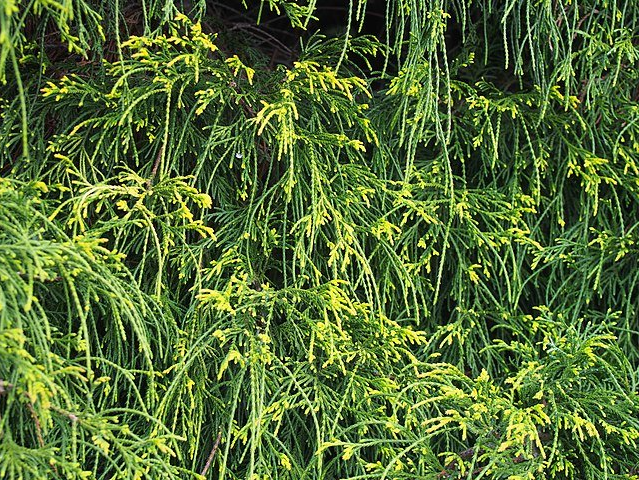
Chamaecyparis pisifera
'Filifera Aurea'
Gold Thread Cypress
– Consistent golden-yellow, finely textured foliage. It has a mop-like form makes a nice accent for the border. Prefers moist, well-drained soil but grows well in heavy clay or dry sand. Shape and size can be controlled by pruning. Slow grower to 5 feet tall and up to 15 feet wide. Best color in full sun. Hardy in USDA zones 5-8.
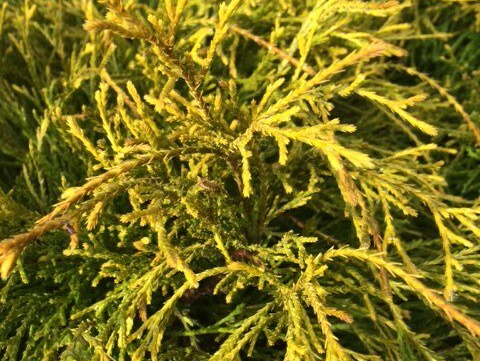
Chamaecyparis pisifera
‘Gold Mops’
Gold Mops Cypress
– Bright gold thread-like evergreen foliage. Unusual stringy foliage adds texture to the garden. Dwarf and compact. 4 feet tall and wide. Full sun to part shade. Hardy in USDA zone 5-7.
Chamaecyparis pisifera
'Snow'
Snow Cypress
– An evergreen with fine, dense blue-green foliage in sprays; white tips; sensitive to sunscald and cold. Needs protection from winter winds; moist, well-drained soil with good air circulation Grows to 5 to 6 feet tall and wide in a tight globe shape. Prefers partial shade. Hardy in USDA zones 6 to 7.

Chamaecyparis pisifera
‘Sungold’
Sungold Cypress
– Mounding, globe to broadly conical, dwarf evergreen shrub with golden, fine-textured, thread-like foliage on weeping branches. Matures at 3-5' tall. Prefers full sun. Hardy in USDA zones 3-7.
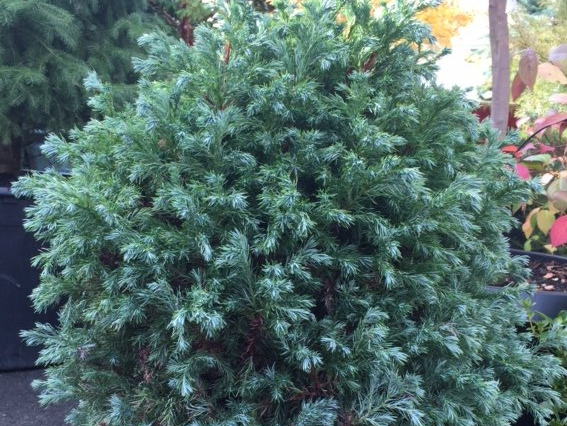
Chamaecyparis pisifera
‘True Blue’
True Blue Cypress
– This miniature conifer has feathery silver foliage. Its petite size makes it suitable for container or rock gardens. Matures at 2’ tall and wide. Prefers full to partial sun. Hardy in USDA zones 4-8.
Chamaecyparis pisifera
‘White Pygmy’
White Pygmy Cypress
– This petite conifer has tiny strands of feathery, white-tipped foliage that produce a velvety texture. Prefers morning sun and afternoon protection, partial sun. Matures at 1.5’ tall x 1.5’ wide. Hardy to USDA zone 5.
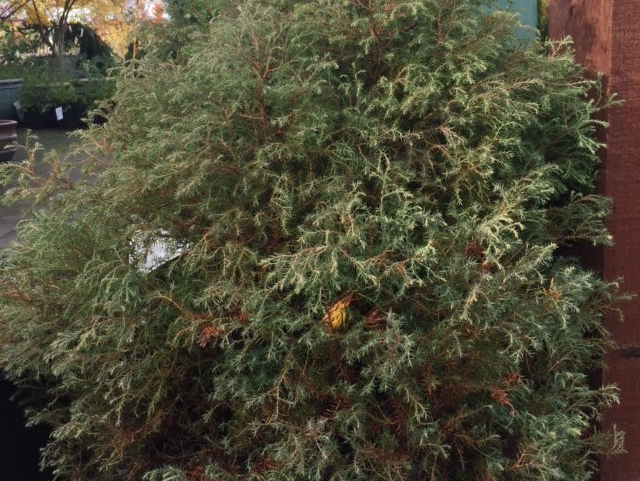
Chamaecyparis thyoides
‘Heatherbun’
Heatherbun Cypress
– This mounding conifer has feathery plumes of olive green with soft plum overtone on slender branches. Foliage turns plum color in winter. Matures at 6’ tall x 4’ wide. Prefers partial to full sun. Hardy in USDA zones 3-8.

Chamaecyparis thyoides
'Red Star'
Red Star White Cypress
– This cute, compact little conifer is perfect for tiny gardens and containers. Only grows to 2.5-3' tall and 1' wide. Its blue-green foliage in summer and Reddish purple-tinted foliage in the winter provides year-round seasonal interest. Prefers full sun. Hardy in USDA zones 3-8.

Cryptomeria japonica
'Black Dragon'
Black Dragon Japanese Cedar
– ‘Black Dragon’ has deep green, needle-like leaves. It likes well-drained, humus-rich, acidic soil, and an average moisture level. It grows wider than high, with an overall pyramidal shape. In 20 year it will reach approximately 7 feet tall and 8 feet wide. Thrives in full or part sun. Hardy in USDA zones 6-9.
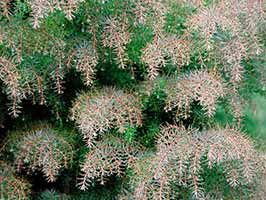
Cryptomeria japonica
'Gyokuryu'
Gyokuryu Japanese Cedar
– This conifer has short, very stiff dark green needles on branches that maintain a dense, broad pyramidal form. It tends to be darker than other Cryptomerias, and holds its color well into the winter season. While it has more of a shrub shape for the first few years of growth, it extends into an upright habit as it matures up to 15-20' tall and 5-7' wide. It has a moderate growth rate of 6-8" per year. High resistance to deer. Prefers full to part Sun. Hardy in USDA zones 5-9.
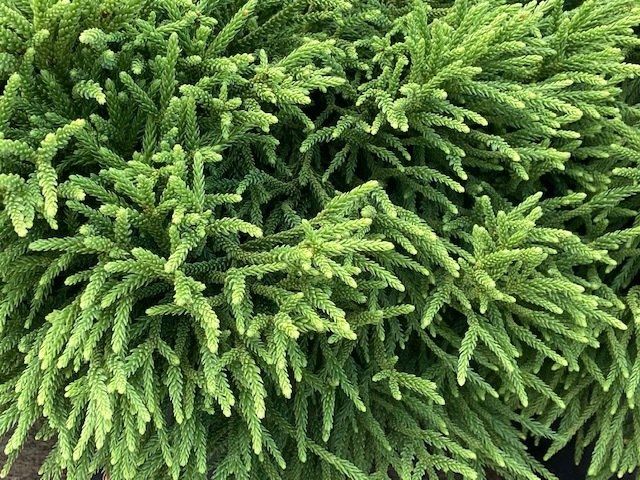
Cryptomeria japonica
'Little Champion'
Little Champion Japanese Cedar
– This dense and compact conifer has curvy branchlets that look like woven rope. It prefers sun or partial shade in moist, well-drained, acid soil in an open, sunny site. Matures at 6' tall and wide. Prefers sun to partial shade. Hardy to USDA zone 6.

Cryptomeria japonica
'Little Diamond'
Little Diamond Japanese Cedar
– A new and unusual slow-growing dwarf variety that grows in a neat, dense, star form. Its bright green foliage is soft to the touch and stays green year-round. Will grow 2' tall and 3' wide in 10-year time span. Prefers well-drained soils. Prefers full sun to part shade. Hardy in USDA zones 5-9.
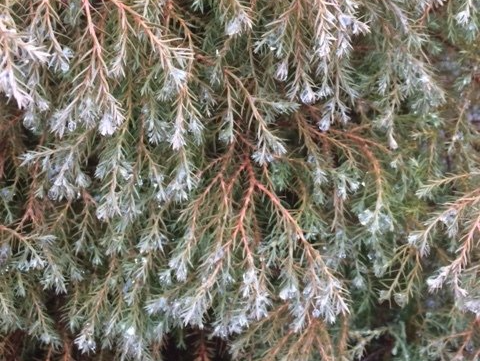
Cryptomeria japonica
'Mushroom'
Mushroom Japanese Cedar
– A dwarf variety with wonderfully drastic seasonal interest with light green foliage in the spring and summer and deep mahogany highlights in the winter. Its small globe shape and delicate airy branches make it usable in any landscape. Deer resistant. Slow growing to 2' tall and 3' wide in 10 years. Prefers full sun to part shade. Hardy to USDA zone 6.
Cryptomeria japonica
'Pygmaea'
Pygmaea Japanese Cedar
– A miniature, low maintenance variety only growing up to 16" tall in a nice bun-shaped. Its lively, bright green foliage gets bronze overtones in the winter. Deer and rabbit resistant. Prefers full sun to part sun. Hardy in USDA zones 5-9.
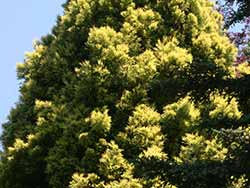
Cryptomeria japonica
'Sekkan Sugi'
Sekkan Sugi
– Foliage is tipped creamy yellow and is most intense when growth is new in spring and early summer. It is a visually dominant tree in the landscape because the foliage color is so intense and shines like a beacon if planted against a medium or dark green backdrop. If you would like to pull out the stops plant in combination with purple foliage plants. Easy to grow in well-drained, humus-rich sand or loam soils that are slightly acid. It requires some supplemental water during extended summer droughts to look its best. An evergreen, columnar coniferous tree that grows to about 8 to 10 feet high by 4 feet wide in ten years. It matures at about 25 to 30 feet high and 10 feet across. Prefers full sun. Hardy in USDA zones 6-9.
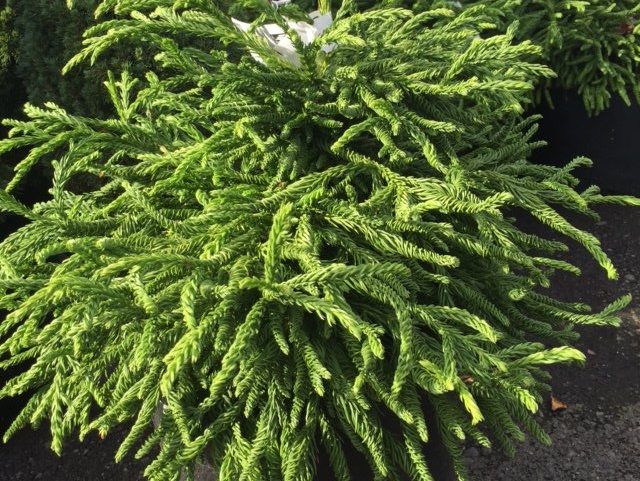
Cryptomeria japonica
‘Spiralis’
Spiralis Japanese Cedar
– Medium-green needles spiral around branchlets and form twisted ropes of ringlet-like foliage. Matures at 6-8' in 10 years. Prefers full sun. Hardy in USDA zones 5-8.
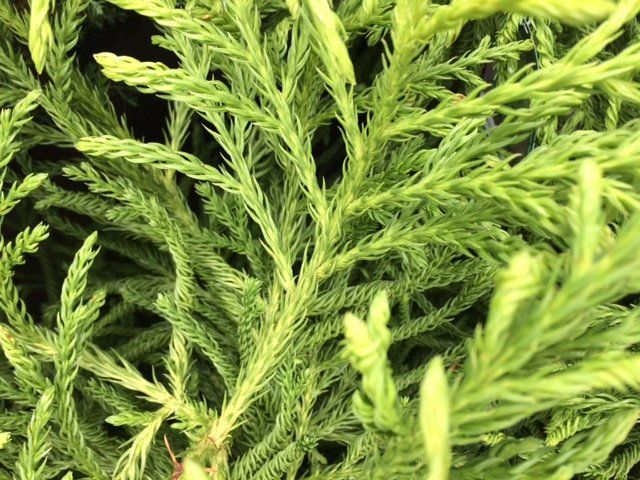
Cryptomeria japonica
'Spiraliter Falcata'
Twisted Japanese Cedar
– The spiral foliage on this unusual Cryptomeria is thinner and lighter green than that of 'Spiralis.' Its habit is more upright too, and the branches twist and curve, making this a collector's conversation piece. Does best on well-drained, moist, acidic soil, in a site protected from winter winds. Slow growing 2-4" per year maturing at 6 feet tall and 4 feet wide. Prefers sun but can tolerate some shade. Hardy in USDA zones 5-8.
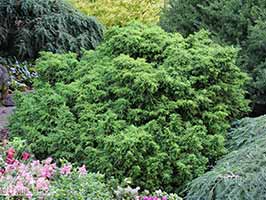
Cryptomeria japonica
'Tansu'
Tansu Japanese Cedar
– Dwarf conifer with dark green, fine-textured dense foliage. Lovely in a container, Japanese or rock garden. Forms a small, irregular pyramid 12" to 18" tall and 9" to 12" wide. Prefers full sun. Hardy in USDA zones 6-9.

Cryptomeria japonica
‘Twinkle Toes’
Twinkle Toes Japanese Cedar
– This conifer has a conical, dense dwarf with striking yellow foliage. Matures at 3’ tall x 2’ wide. Prefers full sun. Hardy to USDA zone 6.
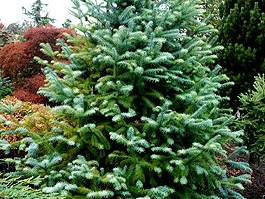
Cunninghamia lanceolata
'Glauca'
Blue China Fir
– Moderately growing evergreen conifer with bright blue foliage provides interest in the landscape. Can grow to 14' tall and 8' wide in 10 years. The bark is a showy characteristic being red and scaly, peeling to reveal inner layers on older specimens. Pyramidal form grows up to 30-75' tall and 20-30' wide. Prefers well-draining soils and full to part sun. Hardy in USDA zones 7-9.
Cupressus macrocarpa
'Donard Gold'
Donard Gold Monterey Cypress
– The bright, dramatic two-tone yellow foliage on this little, citrus-scented conifer is sure to catch everyone's eye. New, outer chartreuse growth and mature, yellow inner foliage stand out atop reddish, cinnamon bark. Grows slowly up to 20-30' tall and 8' wide. Drought tolerant once established. Prefers full sun. Hardy in USDA zones 7-10.
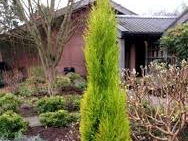
Cupressus macrocarpa
'Gold Crest'
Gold Crest Cypress
– Conifer, dwarf, tight, columnar juvenile form. Foliage bright yellow with a chartreuse green tint. Considered a good container plant. Estimated height in 10 years approximately 6 feet tall and 1-2 feet wide. Prefers full sun. Hardy to USDA zone 7.
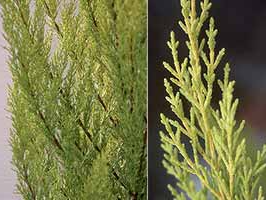
Cupressus macrocarpa
'Golden Pillar'
Golden Pillar Monterey Cypress
– A conifer with soft, golden foliage that grows upward, maintaining a compact, narrow, conical shape. Keeps a narrow form, growing up to 20' tall and only 4' wide. Reveals more yellow foliage when grown in sun. Considered to be more cold hardy than other Monterey Cypress. Hardy in USDA zones 7-10.
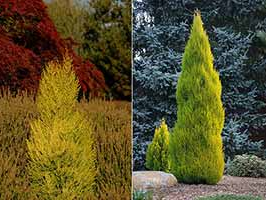
Cupressus macrocarpa
'Wilma Goldcrest'
Wilma Goldcrest Monterey Cypress – This tree has a narrow tapered column with golden foliage make this dwarf conifer an interesting plant for small spaces, containers, and rock gardens. Only 6-8' tall x 2-3' wide after 10 years. Prefers full sun. Hardy in USDA zones 5-7.
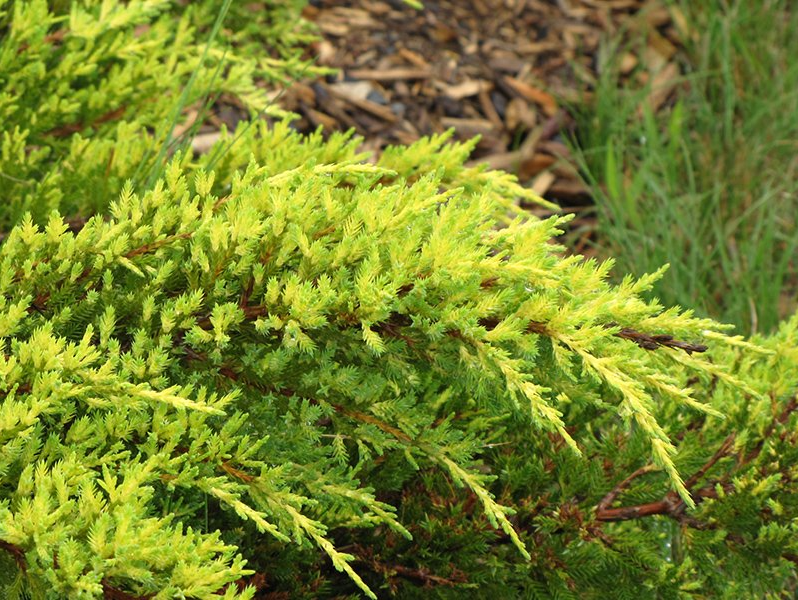
Juniperus chinensis
‘Daub’s Frosted’
Daub’s Frosted Juniper
– This attractively shaped small tree, leaves open dusty green, darkening to rich green, joined by scented white flowers in summer. An excellent small shade tree. Grows to 12 feet tall over 20 yrs. Reaching 20 feet tall at maturity. Prefers full Sun. Hardy to USDA zone 4.
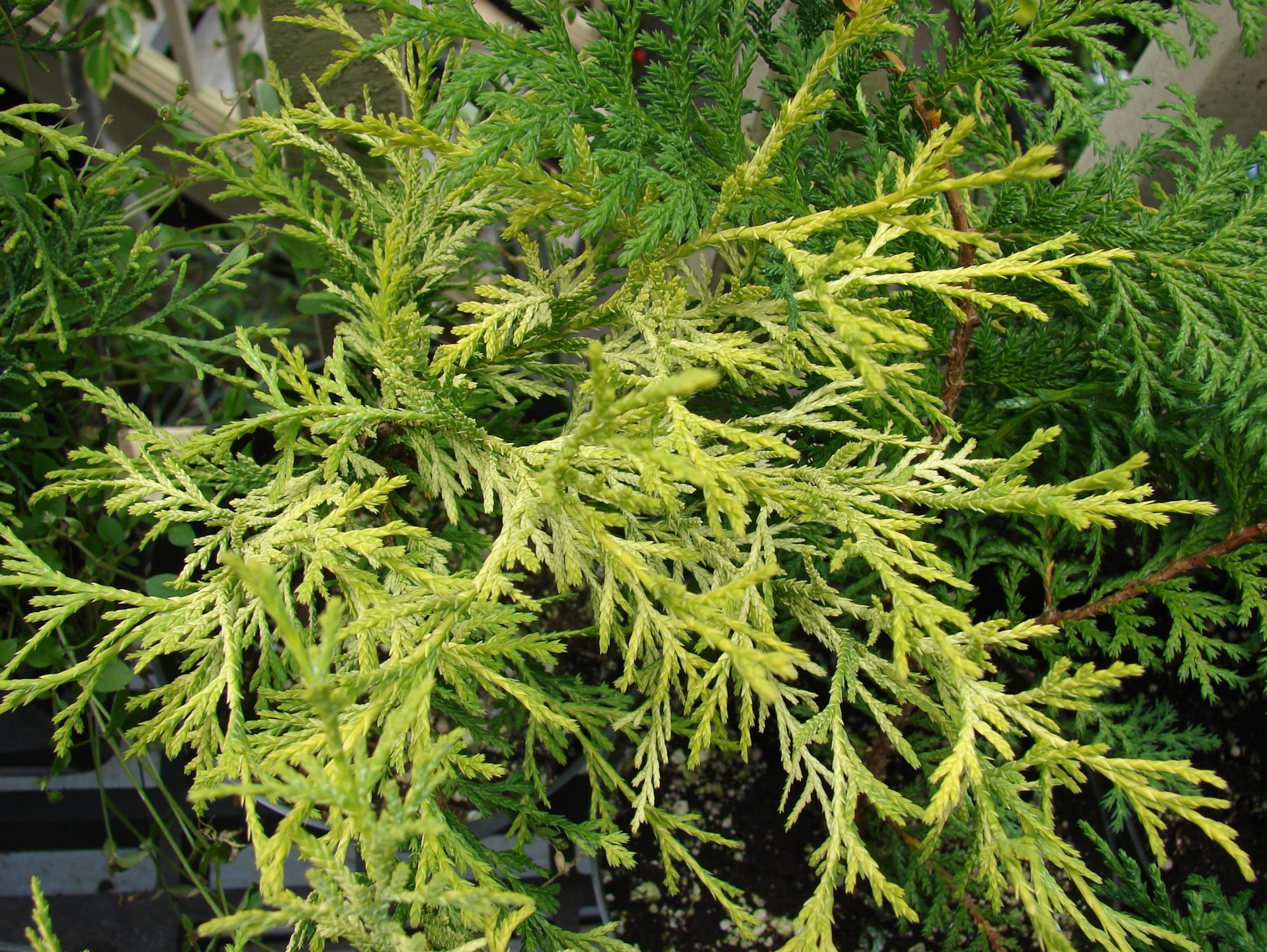
Juniperus chinensis
‘Old Gold’
Old Gold Juniper
– This conifer has a compact, spreading form that typically grows 2-3’ tall and 4-5’ wide. Prefers full sun. Hardy in USDA zones 4-9.
Juniperus communis
'Compressa'
Dwarf Common Juniper
– A low spreading juniper with feathery golden tips of new growth aging to blue-green. Prefers full to partial sun in well-drained soil. Matures at 4’ tall x 8’ wide. Hardy to USDA zone 4.
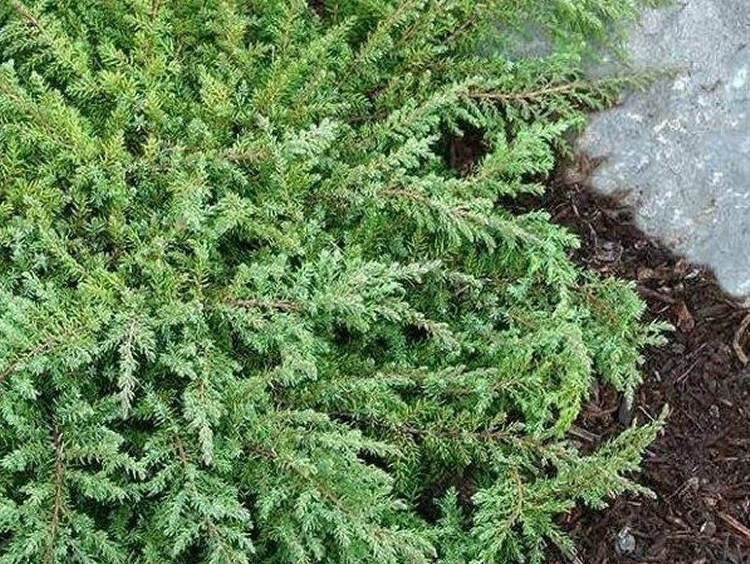
Juniperus communis
‘Green Carpet’
Green Carpet Juniper
– This low growing conifer has new spring growth is bright green while the older foliage turns a dark green. It matures at 6” tall x 3-4’ wide. Prefers full sun. Hardy in USDA zones 2-8.
Juniperus communis
'Gold Cone'
Gold Cone Juniper
– It has a narrow tapered columnar shape and bright gold new growth makes this dwarf conifer an interesting plant for small spaces, containers, and rock gardens. Tolerates dry, shallow or rocky soils and is deer resistant. Slow growing 3-6" per year. It matures at 5 feet tall and 1-2 feet wide. Prefers full sun. Hardy in USDA zones 5-7.
Juniperus horizontalis
‘Gold Strike’
Gold Strike Juniper
– This creeping juniper offers brilliant gold foliage that ages to a coral tone. It has a low mounding form. It is ideal for full sun sites with well-draining soil. Matures at 1’ tall x 3’ wide. Hardy to USDA zone 3.
Juniperus horizontalis
'Lime Glow'
Limeglow Creeping Juniper
– This amazing selection has feathery foliage in electric chartreuse, a color that makes a striking contrast to other greens in the garden. Its spreading, vase form and juvenile foliage lend a cheery presence in almost any garden, including hot, dry conditions. Prefers full sun. Hardy in USDA zones 3-9.
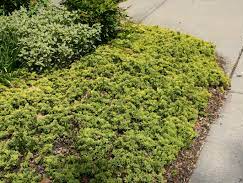
Juniperus horizontalis
‘Mother Lode’
Mother Lode Juniper
– This juniper has golden yellow foliage that ages to plum/burgundy in fall. This low ground cover juniper offers year round-interest. Prefers full to partial sun. Matures at 6” tall x 4’ wide. Hardy to USDA zone 3.
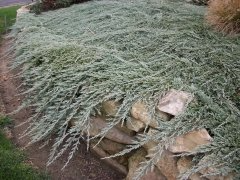
Juniperus horizontalis
‘Pancake’
Pancake Juniper
– This juniper typically grows to only 2” tall but spreads over time to 24” wide. Creeping branches root as they grow along the ground. Prefers full sun. Hardy in USDA zones 3-9.
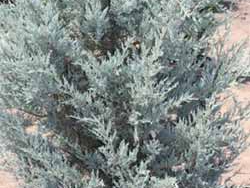
Juniperus scopulorum
'Moonglow'
Moonglow Mountain Juniper
– It bears branches that ascend in a vertically, giving the tree an overall columnar to pyramidal shape at maturity. It can tolerate a wide range of site and soil types, other than wet sites and it can withstand long periods of drought. Typically grows 20 feet tall but often no wider than 5-8 feet. Requires full sun. Hardy in USDA zones 3-9.
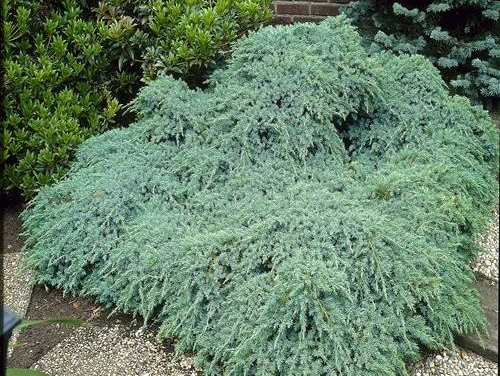
Juniperus squamata
'Blue Carpet'
Blue Carpet Juniper
– This handsome ground cover conifer has rich blue-gray-green foliage. It tolerates a wide range of soil types and is drought tolerant once established. Grows 8 to 12 inches by 4 to 5 feet wide after 20 years. Prefers Sun. Hardy in USDA zones 4-7.
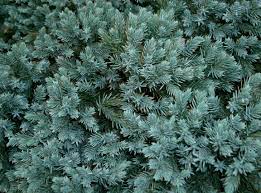
Juniperus squamata
'Blue Star'
Blue Star Juniper
– This conifer has attractive blue foliage on dense spreading and mounding branches. Foliage changes to purplish-blue in winter creating a colorful contrast. Use as a rock garden or border plant. Adaptable and tolerates dry soils. Grows to 2-3 feet high and equal spread. Prefers full sun. Hardy to USDA zone 4.
Juniperus chinensis
‘Trautman’
Trautman Juniper
– This narrow, coarse textured, bluish gray-green spire. Matures at 15’ tall x 4’ wide. Prefers full sun. Hardy to USDA zone 5.
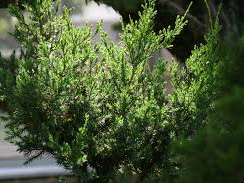
Juniperus chinensis
‘Torulosa’
Torulosa Juniper
– This unique conifer has a twisted form which makes this an excellent accent plant. Matures at 15’ tall x 10’ wide. Prefers full sun. Hardy in USDA zones 5-9.
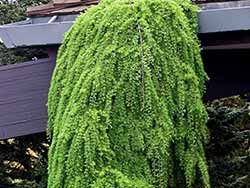
Larix decidua
'Pendula'
Weeping European Larch
– Brilliant lime green foliage in the spring, equally stunning gold fall color. Before needles drop to expose tawny twigs. Deciduous conifer. If not staked it will cover the ground. Prefers full sun. Hardy to USDA zone 3.
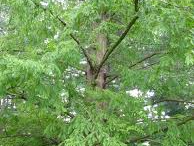
Metasequoia glyptostroboides
Dawn Redwood
– A deciduous tree that grows in a conical shape. It offers feathery, fern-like foliage that is soft to the touch. Foliage emerges light green in spring, matures to deep green in summer, turning red-bronze in fall. Matures at 70’ tall x 15’ wide in ten to twenty years. Prefers full sun. Hardy in USDA zones 4-8.
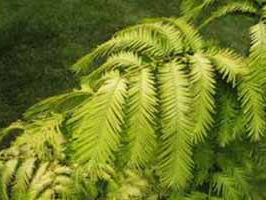
Metasequoia glyptostroboides
'Gold Rush'
Gold Rush Dawn Redwood
– This cultivar features soft, feathery foliage that is distinctively golden-yellow through summer. Foliage gradually turns orange-brown in autumn and then drops its needles to show its branch structure. Reaches 10-15’ tall in 10 years, eventually maturing to 70-100’ tall. This deciduous, coniferous tree grows in a conical shape to 100’ tall. Best grown in moist, humus-rich, well-drained soil. Appreciates consistent moisture. Prefers full sun. Hardy in USDA zones 4-8.
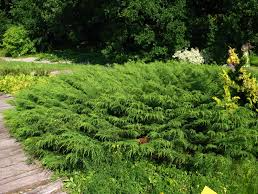
Microbiota decussata
‘Condavis’
“FuzzBall” Condavis (Fuzzball) Siberian Cypress
– A handsome conifer that forms a horizontal mounding shape. The foliage is a fuzzy bright green in summer that turns to a purplish-brown color in the winter. Matures at 1-2’ tall x 3’ wide. Prefers full sun. Hardy in USDA zones 2-8.
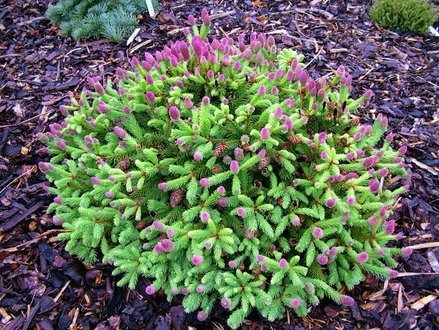
Picea abies
‘Acrocona Pusch’
Acrocona Pusch Norway Spruce
– This dwarf mound-shaped conifer shrub makes a beautiful, easy to grow accent plant. Grows slowly, 3 to 5 inches per year. It bears medium-green needles and tiny cones appear red in spring, then maturing to brown. Matures at 18-36” tall and wide. Prefers full sun. Hardy in USDA zones 2-8.
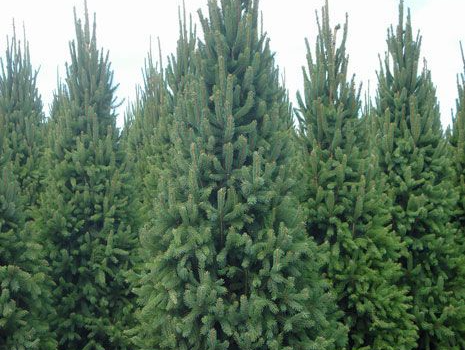
Picea abies
'Cupressina'
Fastigiate Norway Spruce
– This fast-growing, conical shaped conifer forms a spire of dense dark green needles. Matures at 20-30’ tall x 6-10’ wide. Prefers full sun. Hardy to USDA zone 3.
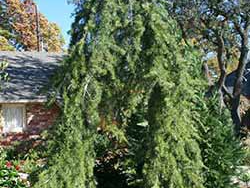
Picea abies
‘Farnsburg’
Farnsburg Norway Spruce
– This weeping conifer has stiff dark green needles. Matures at 4-15’ tall x 4-15’ wide. Prefers full sun. Hardy to USDA zone 3.

Picea abies
'Little Gem'
Little Gem Dwarf Norway Spruce
– This dense, globe-shaped conifer is a petite accent plant. Maturing at 18” tall and wide. Prefers full sun. Hardy in USDA zones 2-8.
Picea abies
'Motala'
Motala Spruce
– Blunt-tipped needles radiate out and downward on short, stout, vertical branches. Needles are blue-green. Habit is mound to globose shaped. Matures at 4’ tall x 4’wide. Prefers full sun. Hardy to USDA zone 3.
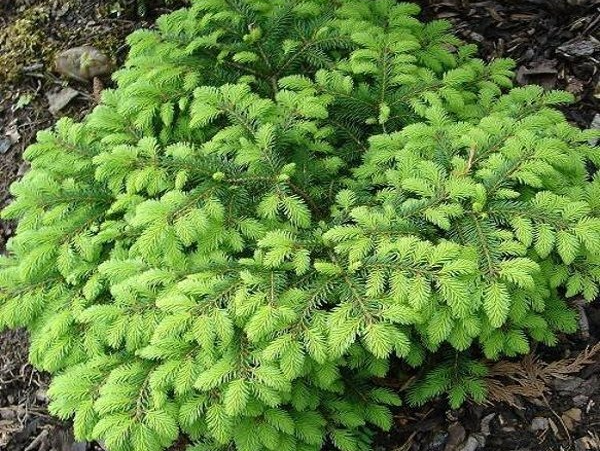
Picea abies
'Nindiformis'
Nest Spruce
– This unique conifer forms a nest-like shape as it matures. Bearing horizontal branches that become a shrub with a flatten to a globe shape. Matures at 2-8’ tall x 3-12’ wide. Prefers full sun. Hardy in USDA zones 3-7.
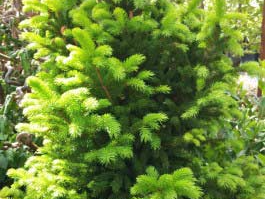
Picea abies
'Ohlendorfii'
Ohlendorfii Norway Spruce
– This dwarf mounding conifer makes an excellent accent plant for borders and rock gardens. Matures at 3-4’ tall x 5-10’ wide. Prefers full sun. Hardy to USDA zone 3.
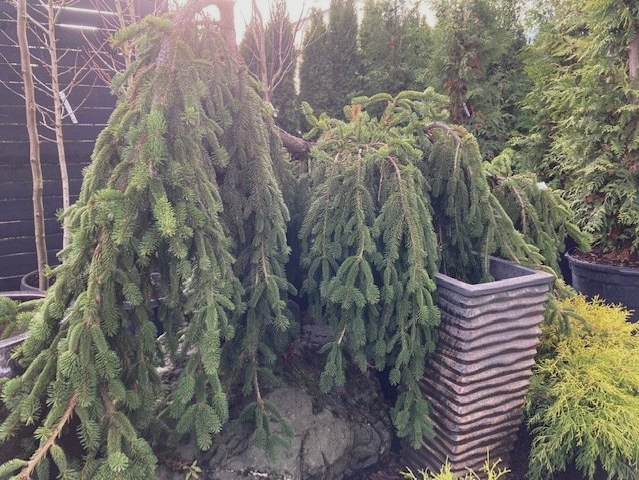
Picea abies
'Pendula'
Weeping Norway Spruce
– This unique cultivar has deep green needles and a weeping habit that can form an asymmetrical shape. Matures at 4-15’ tall x 4-15’ wide. Prefers full sun. Hardy in USDA zones 3-7.
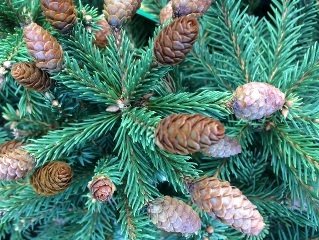
Picea abies
‘Pusch’
Pusch Norway Spruce
– This small low growing Norway spruce bears beautiful magenta cones in spring. This charming mounding variety is a unique feature in a conifer garden. Prefers full sun to partial shade. Grows to 2’ tall x 3’ wide. Hardy to USDA zone 3.
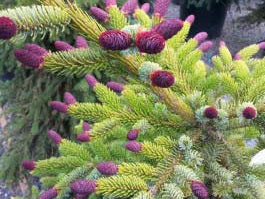
Picea bicolor
'Howell's Dwarf'
Dwarf Spruce
– It has a spreading flat-topped form that grows in an irregular shape. Bicolor needles are green on top and silver-blue beneath. Cones emerge a unique reddish-purple color. Matures at 4-6’ tall x 2-5’ wide in ten years eventually reaching up to 20' tall. Prefers full sun. Hardy in USDA zones 3-7.
Picea glauca
‘Candlelight’
Candlelight Alberta Spruce
– This dwarf conifer has a golden flush of new growth in the summer that resembles a candle's flame. Matures at 6' tall in 10 years. Prefers full sun. Hardy in USDA zones 3-8.
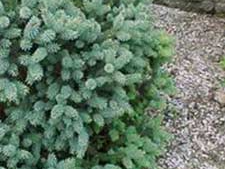
Picea glauca
‘Cecilia’
Cecilia Alberta Spruce
– This dwarf shrubby conifer bears tight blueish-green needles. Matures at 2’ tall x 2’ wide. Prefers full sun. Hardy to USDA zone 3.
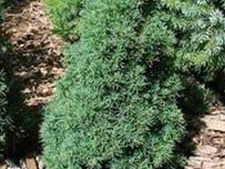
Picea glauca
'Jean's Dilly'
Dwarf Alberta Spruce
– This upright, narrow tree forms a perfect cone shape and never needs to be sheared. Matures at 2-5’ tall x 1-21/2’ tall. Prefers full sun. Hardy in USDA zones 3-6.
Picea glauca
'Pendula'
Weeping White Spruce
– An elegant, dramatic conifer with a formal, narrow, conical shape and its pendulous stiffly held, cascading branches and loads of interesting light, gray-green foliage that make a graceful statement. Grows 10-12" per year, reaching 30' tall, 15' wide. Prefers full sun. Hardy in USDA zones 2-9.
Picea glauca
‘Pixie Dust’
Pixie Dust Spruce
– This is an extremely dense, compact and slow growing, conifer. It has dark green needles on a conical conifer grows to 1.5’ tall x 6” wide. Prefers full sun. Hardy to USDA zone 4.
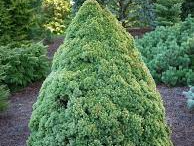
Picea glauca
'Rainbows End'
Rainbows End White Spruce
– This variety of Alberta spruce bears bright lime green new growth tips in spring and a second flush in summer, making an eye-catching specimen in your landscape. Growing in a conical for this tree matures at 6’ tall x 2’ wide. Prefers full sun. Hardy to USDA zone 4.
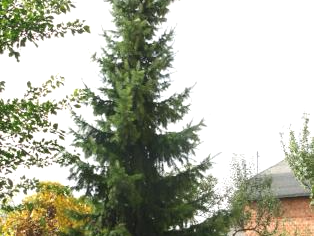
Picea omorika
Serbian Spruce
– One of the best evergreens for the urban landscape. This disease and insect-resistant tree forms a narrow column with gracefully bowing side branches. Stately as a single specimen, its dark green needles with silver-blue undersides create an interesting bicolor effect. It is tolerant of a wide range of soils providing drainage is good and is drought tolerant once established. Slow growing 12-15 feet tall in 10 years, maturing at 20-30 feet tall in 30 years with a 10-foot spread. This spruce is best in full sun but will tolerate light shade. Hardy in USDA zones 5-8.

Picea omorika
‘Bruns’
Bruns Serbian Spruce
– This narrow conifer reaches 15 feet in the first 10 years; ultimately 30 feet with age. Offering blue-green foliage and dark plum cones. Matures at 30’ tall x 4’ wide. Prefers full sun and well-draining soil. Hardy to USDA zone 4.
Picea omorika
'Nana'
Dwarf Serbian Spruce
– This conifer is a densely-branched, dwarf evergreen tree with a broad conical shape. Prefers full sun to part shade. Hardy in USDA zones 4-7.
Picea omorika
'Pimoko'
Pimoko Serbian Spruce
– The blue-green needles on this conifer show their bright silver undersides giving this compact cultivar creating interest and sparkle. Matures at 18" tall by 30" wide. Prefers full sun. Hardy in USDA zones 2-8.
Picea omorika
‘Silberblue’
Silberblue Serbian Spruce
– This conical conifer offers two-tone needles, green with silvery-blue undersides on upright branches. Matures at 25’ tall x 15’ wide. Prefers full sun. Hardy to USDA zone 4.
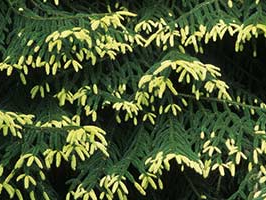
Picea orientalis
‘Aureospicata’
Aureospicata Oriental/Caucausian Spruce
– This stately evergreen has short, dark green needles on stiff branches. Emerging lime green new growth tips in spring make a striking contrast against the deep green mature growth. Grows in a graceful and narrow pyramidal shape. Matures at 60’ tall x 30’ wide. Prefers full sun. Hardy to USDA zone 5.
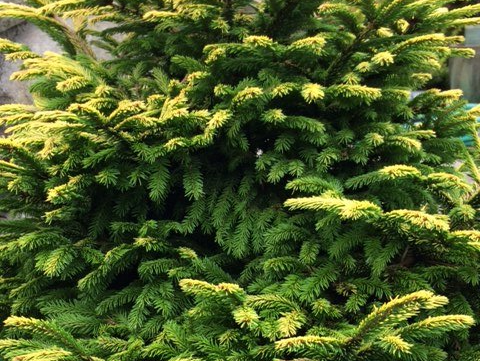
Picea orientalis
‘Firefly’
Firefly Spruce
– This spruce has thin needles that open in spring as a bright yellow, maturing to gold and standing out against the green interior foliage. Matures a modest 6’ tall x 4’ wide. Prefers full sun. Hardy to USDA zone 4.
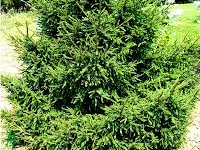
Picea orientalis
‘Gowdy’
Gowdy Oriental Spruce
– A medium to large, densely-branched conical-shaped tree with dark green small needles. Matures at 6- 10’ tall x 3-6’ wide. Prefers full sun. Hardy in USDA zones 4-7.

Picea orientalis
'Skylands'
Yellow Oriental Spruce
– This variety is slow-growing, upright, and has a conical-pyramidal shape. Offering needles are bright gold in full sun or light yellow in part shade. Matures at 10-35’ tall x 4-12’ wide. Prefers full to partial sun. Hardy in USDA zones 4-7.
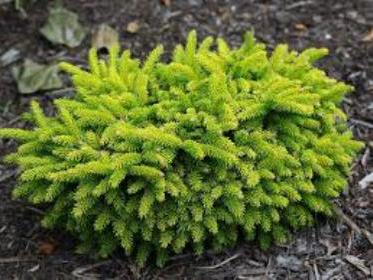
Picea orientalis
'Tom Thumb’
Tom Thumb Spruce
– Striking golden fingers of tight foliage point out from the center of this attractive layered globe. The combination of brightly colored needles, extremely slow growth and compact nest shape make 'Tom Thumb' desirable for small garden spaces or in trough or rock garden. Chosen by the American Conifer Society as 2007 Collector’s Conifer of the Year, this compact conifer prefers ample moisture and rich, well-drained soil. A very slow conifer grown only 1" per year. Does best in full sun or part shade. Hardy to USDA zone 4.

Picea orientalis
'Glauca Globosa'
Dwarf Globe Blue Spruce
– This dwarf, globe-shaped, blue-needled, evergreen shrub forms a flattened top as it matures. Matures at 3-5’ tall x 4-6’ wide. Prefers full sun. Hardy in USDA zones 2-7.
Picea pungens
‘Glauca Pendula’
Weeping Blue Spruce
– This weeping Colorado Blue Spruce forms a narrow pendulent shape. Matures at 12’ in ten years. Prefers full sun. Hardy to USDA zone 3.
Picea pungens
‘Mrs. Cesarini’
Mrs. Cesarini Colorado Spruce
– Bright green needles are born on dense branches. This dwarf conifer forms a mound. Matures at 3’ tall x 4’ wide. Prefers full sun. Hardy to USDA zone 2.
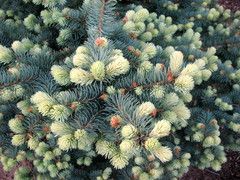
Picea pungens
‘Niemetz’
Niemetz Colorado Spruce
– New growth in spring is a creamy white flush is a striking contrast against the older blue foliage. Matures at 10’ tall x 8’ wide. Prefers full sun. Hardy to USDA zone 2.
Picea pungens
‘Ruby Teardrops’
Ruby Teardrops Colorado Spruce
– This unique dwarf blue selection of Colorado spruce has vibrant blue new growth. Bears petite cones are red to magenta that contrast the blue foliage. Matures at 3’ in ten years. Prefers full sun. Hardy to USDA zone 3.
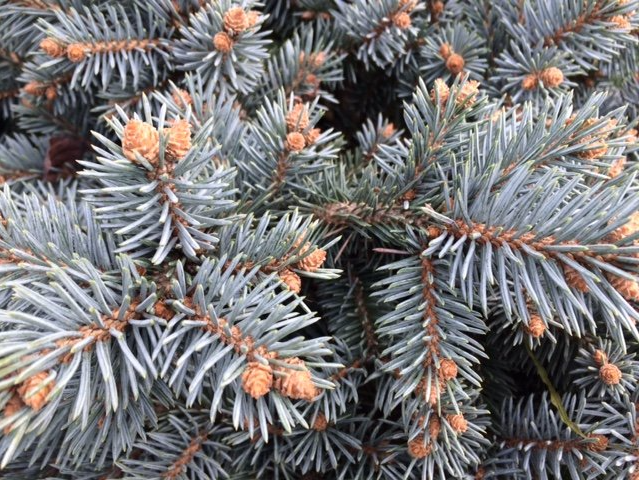
Picea pungens
‘St. Mary’s Broom’
St. Mary’s Broom Spruce
– This dwarf, blue, bun-shaped conifer has relatively long, widely-angled needles. It has mounding or globose habit. Matures to 1’ tall x 2’ wide. Prefers full sun. Hardy to USDA zone 2.
Picea pungens
‘The Blues’
The Blues Colorado Spruce
– Blue spring foliage drapes off of weeping branches creating cascading year-round color. Matures at 5-6’ tall and the width varies. Prefers full sun. Hardy in USDA zones 2-8.
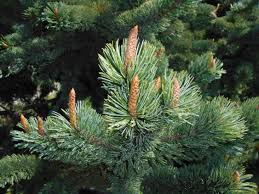
Pinus aristata
Bristlecone Pine
– Irregular, sweeping branches display tight bundles of short dark green needles and brown cones. Matures at 20’ tall and wide. Prefers full sun. Hardy in USDA zones 4-7.
Pinus aristata
‘Joe’s Bess’
Joe’s Bess Pine
– Dense clusters of two-toned needles point towards the tip of each branch forming a conical/pyramidal shaped conifer. The formal, slow-growing tree requires little or no pruning. Matures at 6’ tall x 4’ wide. Prefers full sun. Hardy to USDA zone 4.

Pinus banksiana
'Schoodic'
'Prostrate Jack Pine
- 'Schoodic'
– (pronounced skoo dik') An exceptional, dense, ground-hugging native selection of Jack Pine. Use the spreading, low-growing plant with short, emerald green needles to drape down a bank or sprawl over another challenging site. Typical of the species, 'Schoodic' is extremely hardy and adaptable; it tolerates heat, cold, and dry, sandy or poor soils. Prefers full sun. Hardy to USDA zone 2.
Pinus cembra
‘Glauca Compacta’
Glauca Compacta Pine
– A dense narrow conical conifer with blue-green foliage. Matures at 12’ tall x 8’ wide. Prefers full sun. Hardy in USDA zones 5-8.
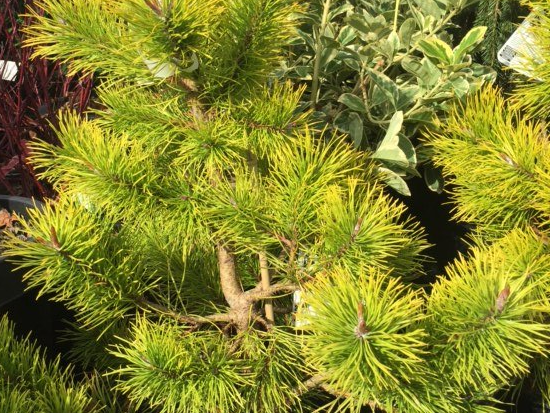
Pinus contorta
‘Chief Joseph’
Chief Joseph Pine
– Green spring and summer needles mature to yellow-green in late summer, and by early winter the foliage turns brilliant gold. Matures at 4’ tall x 2’ wide. Prefers full sun. Hardy in USDA zones 5-9.

Pinus contorta
'Taylor's Sunburst'
Taylor's Sunburst Lodgepole Pine
– Brilliant, golden-yellow, new growth erupts in spring and makes 'Taylor's Sunburst' a vibrant show-stopper. The striking color lasts for weeks, and then gradually softens to a light, yellow-green as the foliage hardens. Red pollen cones add contrast to this extraordinary Pine. Prefers full sun. Hardy to USDA zone 4.
Pinus contorta var. contorta
'Pom-Pom'
Pom Pom Pine
– This handsome conifer has been trained into unique architectural specimen. Deep green needles are found on this rugged coastal Northwest native. Matures at 20’ tall x 15’ wide. Prefers full sun. Hardy in USDA zones 5-10.
Pinus densiflora
'Aurea'
Golden Japanese Red Pine
– A Golden form of Japanese red pine. A conical-shaped shrubby pine with brilliant golden needles. Matures at 15-25’ x 15’ wide. Prefers partial sun. Hardy in USDA zones 4-8.
Pinus densiflora
‘Low Glow’
Low Glow Pine
– This dwarf cultivar forms a dense, compact, rounded mound of foliage to 3-4’ tall over the first 10 years. Prefers full sun. Hardy in USDA zones 3-7.
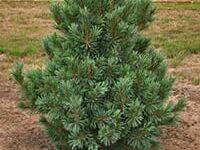
Pinus flexis
'Vanderwolf's Pyramid'
Vanderwolf's Pyramid Limber Pine
– This upright, pyramidal conifer bears twisted, silvery blue-green needles. Matures at 20-30’ tall x 10-15’ wide. Prefers full sun. Hardy in USDA zones 4-7.

Pinus leucodermis
Bosnian Pine
– This conifer offers unique purple-blue cones that mature to brown. It has a dense, pyramidal shape and makes an excellent accent or screening tree. Matures at 40’ tall x 10’ wide. Prefers full sun. Hardy in USDA zones 4-8.
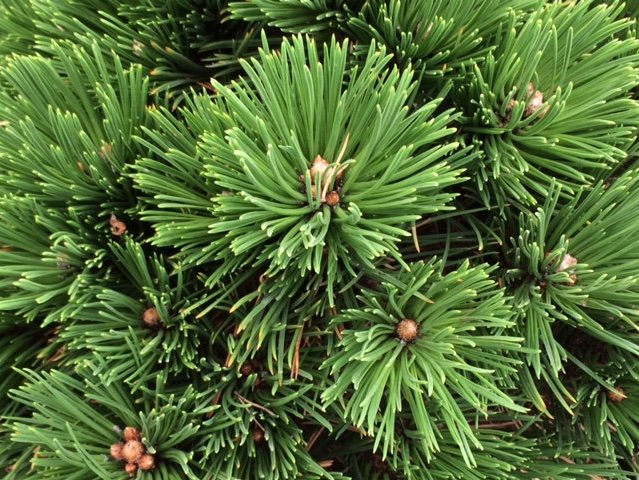
Pinus leucodermis
‘Banderica’
Banderica Bosnian Pine
– This beautiful cultivar of a Dwarf Bosnian Pine has clusters of clean, lustrous, dark green needles with white resin on buds, candles and stems. Matures at 3’ tall and wide. Prefers full sun. Hardy to USDA zone 4.
Pinus leucodermis
‘Indigo Eyes’
Indigo Eyes Bosnian Pine
– This broadly upright tree develops an open, slightly asymmetrical shape. This conifer retains its cones on stiff branches that bear dark green needles. Matures at 10’ tall x 8’ wide. Prefer full sun. Hardy to USDA zone 5.

Pinus leucodermis
‘Schmidtii’
Schmidtii Bosnian Pine
– A dense, mounded pine with rich green foliage and tight branch structure. Matures at 3’ tall and wide. Prefers full sun. Hardy in USDA zones 4-8.
Pinus mugo
‘Aurea’
Golden Mugo Pine
– This mounding conifer bears golden needles that age to chartreuse in summer. Maturing to 4’ tall x 6’ wide. Prefers full sun. Hardy to USDA zone 2.
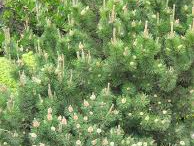
Pinus mugo var. mughus
Dwarf Mugo Pine
– This pine grows as a dense shrub or a low multi-trunked tree. It has dark green needles on stiff upright branches. It is an excellent choice for the Northwest landscape or Asian garden. Matures at 3-4’ tall x 6-8’ wide. Prefers full sun. Hardy to USDA zone 3-8.
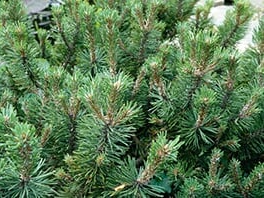
Pinus mugo var. pumilo
Prostrate Mugo Pine
– This dwarf variety has a dense spreading habit. It often grows low to the ground with upright branches. Matures at 3-5’ tall x 6-10’ wide. Prefers full sun. Hardy in USDA zones 3-7.
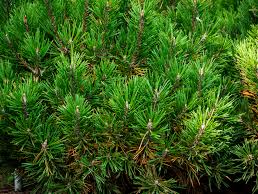
Pinus mugo
‘Mops’
Mops Mugo Pine
– This dwarf pine is perfect for small gardens, with its symmetrical growth and compact, rounded habit. Matures at 5’ tall and wide. Prefers full sun. Hardy in USDA zones 2-7.
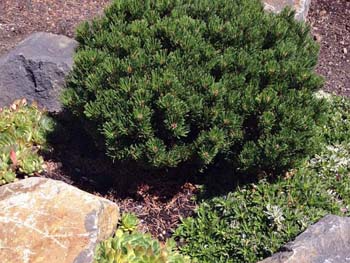
Pinus mugo
‘Sherwood Compact’
Sherwood Compact Mugo Pine
– A true dwarf pine with compact stiff branches producing deep green needles. Matures at 3’ tall x 4’ wide. Prefers full sun. Hardy to USDA zone 2.
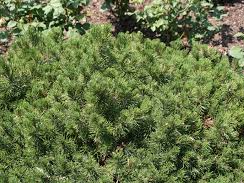
Pinus mugo
‘Slow Mound’
Slow Mound Mugo Pine
– This handsome conifer has an evenly mounded habit of finely textured, dark deep green needles. Matures at 1-2’ tall x wide. Prefers full sun. Hardy in USDA zones 2-8.
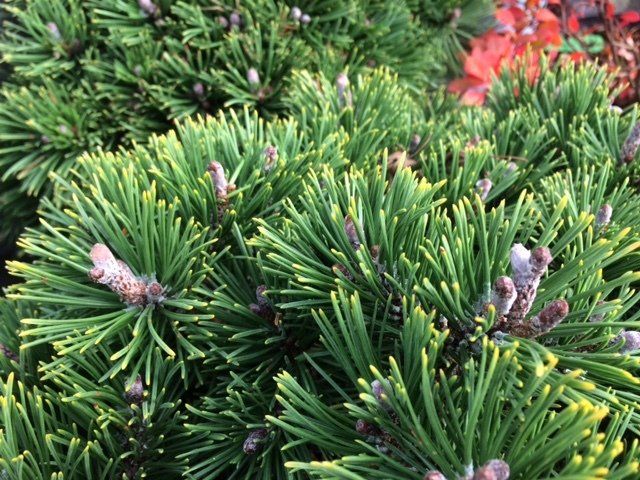
Pinus mugo
'White Bud'
White Bud Mugo Pine
– This compact dwarf pine grows in a rounded mound. It is an excellent choice for rock gardens. Matures at 2’ tall x 4’ wide. Prefers full sun. Hardy to USDA zone 2.
Pinus mugo
‘Wintersonne’
Wintersonne Mugo Pine
– This hardy, compact mugo pine is a rich dark green that turns brilliant gold with the winter's chill. Matures at 6’ tall x 4’ wide. Prefers full sun. Hardy to USDA zone 2.
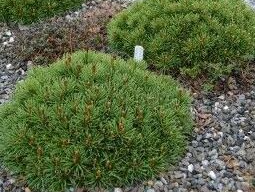
Pinus mugo
‘Valley Cushion’
Valley Cushion Mugo Pine
– A dwarf cultivar with a rounded form that typically matures to only 2-3’ tall and wide. Prefers full sun. Hardy in USDA zones 2-7.
Pinus nigra
‘Komet’
Komet Black Austrian Pine
– A dwarf columnar variety conifer that is perfect for screening or a specimen for narrow spaces. It offers gray-green needles on upright branches that are compact and dense. Matures at 12’ tall x 4’ wide. Hardy to USDA zone 3.

Pinus nigra
'Oregon Green'
Oregon Green Black Austrian Pine
– This pine tree forms an open upright habit with deep green needles on stiff stems resembling bottle brushes. Matures at 18’ tall x 20’ wide over time. Prefers full sun. Hardy in USDA zones 4-8.
Pinus parviflora
‘Aoi’
Aoi White Pine
– A narrow, upright, small tree with curved blue-grey needles held in tight bundles held along the branches. Matures at 10-12’ tall and 6-8’ wide. Prefers full sun. Hardy in USDA zones 4-7.
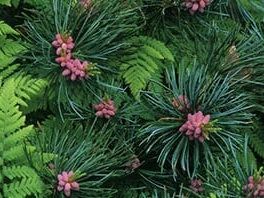
Pinus parviflora
'Glauca'
Pinus parviflora Glauca
– Group represents blue-needled selections of the lovely Japanese white pine. Each of their blue needles has a white stripe. These slow-growing evergreen trees form a dense, conical pyramid when they are young and gradually develop wide-spreading branches and a flat-topped shape with maturity. The combination of handsome foliage and attractive overall shape make these outstanding landscape trees. Plant it in well-drained soil. Grows to 8-12 feet tall and 5-8 feet wide in 10 years, maturing to 50 feet tall and 30 feet wide. This beautiful pine grows best in full sun, but it can tolerate an hour or two of shade a day. Hardy in USDA zones 5-8.
Pinus parviflora
‘Goldilocks’
Goldilocks Pine
– This conifer has a natural sweeping habit on an upright form. It bears golden needles with silver highlights. Matures at 8’ tall x 6’ wide. Prefers full sun. Hardy to USDA zone 5.
Pinus parviflora
‘Kinpo’
Kinpo Pine
– This conifer has a mounding habit and dark green needles. Matures at 3-4’ tall and wide. Prefers full sun. Hardy to USDA zone 4.
Pinus parviflora
‘Tanima no yuki’
Snow in the Valley Pine
– This very slow-growing dwarf, begins its life as an irregular mound developing into a small, broad, upright form. It completes its new candle growth in spring and it unfurls its curvy, creamy-white, variegated needles. Matures at 3’ tall x 2’ wide. Prefers full sun. Hardy to USDA zone 5.
Pinus strobus
'Blue Shag'
Dwarf Blue Eastern White Pine
– This dwarf, dense, mounding pine bears short, blue-green needles that are soft to the touch. Matures at 2-4’ x 2-4’ wide. Prefers full sun. Hardy in USDA zones 3-8.
Pinus strobus
'Fastigiata'
Fastigata Eastern White Pine
– This small to medium-sized conifer has a columnar shape with upright branches. It is a fast-growing tree with bluish-green needles and light brown cones. Matures at 30-40’ tall x 7-10’ wide. Prefers full sun. Hardy in USDA zones 3-8.
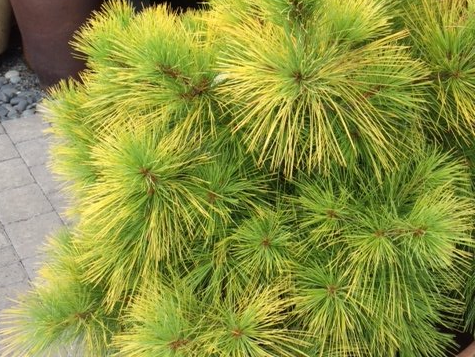
Pinus strobus
‘Louie’
Louie Eastern White Pine
– Vibrant-golden needles that stay brightly-colored year-round. Large, open and upright, the symmetrical habit. Matures at 20’ tall x 15’ wide. Prefers full sun. Hardy to USDA zone 3.

Pinus strobus
‘Mini Twist’
Mini Twist Eastern White Pine
– This petite mounding conifer bears twisted curvy needles adding a unique texture to the landscape. Matures at 6’ tall x 4’ wide. Prefers full sun. Hardy to USDA zone 3.
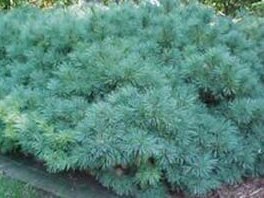
Pinus strobus
'Nana'
Dwarf Eastern White Pine
– This compact, mounded and spreading, dwarf pine is slow-growing. Bearing soft silvery blue-green needles. Matures at 2-7’ tall x 3-10’ wide. Prefers full sun. Hardy in USDA zones 3-8.
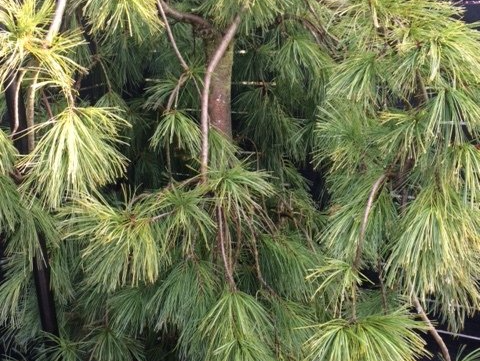
Pinus strobus
'Pendula'
Weeping Eastern White Pine
– This semi-dwarf weeping tree varies in its shape due to its pendulant habit. Bearing soft green to blue-green needles and attractive cones. Matures at 6-15’ tall x 10-20’ wide. Prefers full sun. Hardy in USDA zones 3-8.

Pinus strobus
'Torulosa'
Twisted Eastern White Pine
– This narrow dwarf conifer develops short side branches making it ideal for small spaces. The twisting blue-green needles offer a unique texture. Matures at 15’ tall x 15’ tall x 3’ wide. Prefers full sun. Hardy in USDA zones 3-8.
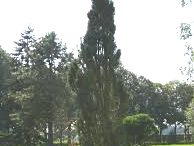
Pinus sylvestris
'Fastigiata'
Fastigiata Scotch Pine
– This upright columnar pine forms a punctuation mark in the landscape. It has medium blue-green needles and attractive medium-sized cones. Matures at 20-25’ tall x 6-8’ wide. Prefers full sun. Hardy in USDA zones 3-7.
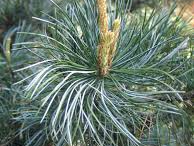
Pinus sylvestris
‘Glauca Nana’
Glauca Nana Scotch Pine
– This shrubby conifer has a rounded shape with dark green needles on dense, horizontal branches. It takes well to pruning and shaping. Matures to 6’ tall and wide. Prefers full sun. Hardiness USDA zones 2-7.
Pinus sylvestris
'Poodles'
Poodles Scotch Pine
– This dwarf pine has been trained to form tufts of needle growth on outstretched arm branches in a traditional Asian style. This tree must be kept pruned to maintain the poodle-puff style. Matures at 5’ tall x 4’ wide. Prefers full sun. Hardy to USDA zones 3.

Pinus sylvestris
'Repens'
Repens Scotch Pine
– This low-growing pine bears deep green needles, and its ground cover-like habit is ideal for rock gardens. Matures at 18-14” tall x wide. Prefers full sun. Hardy in USDA zones 2-8.
Pinus thunbergii
‘Banshosho'
Banshosho Japanese Black Pine
– This dwarf upright tree is slow-growing and offers dark green needles and white candles of new growth in spring. Matures at 3-5’ tall x 3-5’ wide. Prefers full sun. Hardy in USDA zones 5-8.
Pinus thunbergii
‘Kotobuki’
Kotobuki Japanese Black Pine
– This upright form of Japanese Black Pine grows in a narrow upright habit, making it ideal for smaller spaces. Matures at 10’ tall x 6’ wide. Prefers full sun. Hardy to USDA zone 5.
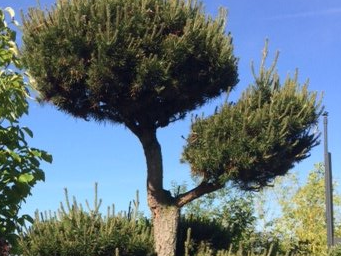
Pinus thunbergii
‘Pom Pom’
Pom Pom Japanese Black Pine
– This handsome conifer has been trained into a unique architectural specimen. Matures at 20’ tall x 12’ wide. Prefers full sun. Hardy in USDA zones 5-8.

Pinus thunbergii
'Thunderhead'
Thunderhead Japanese Black Pine
– This shrubby compact pine grows upright in an irregular shape. It matures at 10’ tall x 15’ wide. Prefers partial to full sun. Hardy in zones USDA 5-10.
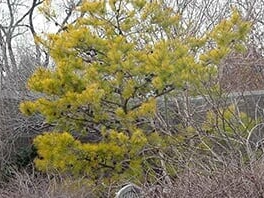
Pinus thunbergii
‘Wate’s Golden’
Wate’s Golden Virginia Pine
– This conifer grows in an open and irregular asymmetrical pattern. The golden needles are an outstanding feature in winter. Matures at 15-30' tall x 10-20’ wide. Prefers full sun. Hardy to USDA zone 4.
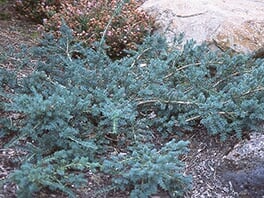
Podocarpus alpinus
‘Blue Gem’
Blue Gem Tasmanian Podocarpus
– This uncommon conifer grows in a dwarf shrubby habit. The new growth in spring is pinkish-red maturing to a blue-green. Matures at 1’ tall x 3’ wide. Prefers full sun or light shade. Hardy to USDA zone 7.
Podocarpus alpinus
'Red Tip'
Mountain Plum Pine
– This beautiful and unique conifer has a dwarf spreading habit and bears dark blue-green foliage that starts deep reddish-purple in spring. Matures at 1’ tall x 3’ wide. Prefers partial sun. Hardy to USDA zone 7.

Pseudotsuga menziesii
Douglas Fir
– This icon of the Pacific Northwest forest had deep blue-green needles and narrow linear cones. It grows in an upright form with draping branches. Maturing at 40-80’ tall x 12-20’ wide. Prefers full sun. Hardy in USDA zones 4-6.
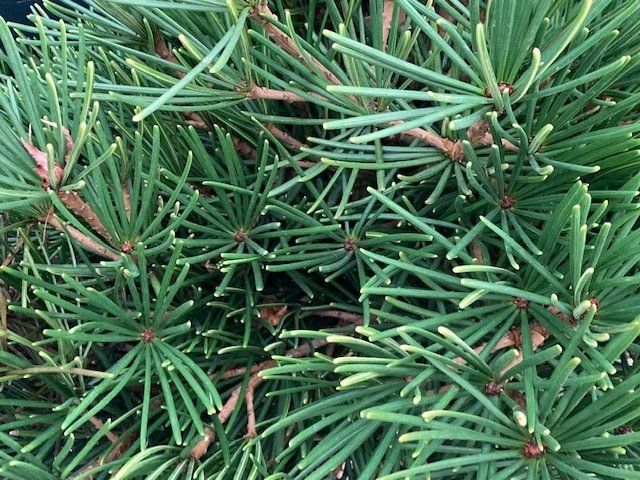
Sciadopitys verticillata
Japanese Umbrella Pine
– This uncommon pine offers long dark green flat needles. Growing in a pyramidal shape it is a striking accent plant. Matures at 20’ tall x 15’ wide. Prefers full to partial shade. Hardy to USDA zone 5.
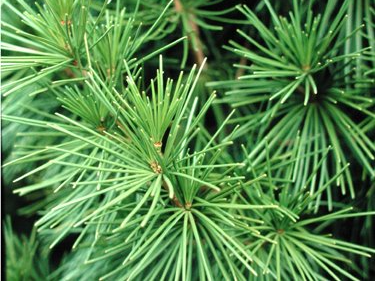
Sciatopitys verticillata
‘Wintergreen’
Wintergreen Japanese Umbrella Pine
– Bearing long deep green needles, this unique conifer adopts a pyramidal form. Ideal for a focal point. Matures at 20’ tall x 15’ wide. It prefers full to partial shade. Hardy to USDA zone 5.
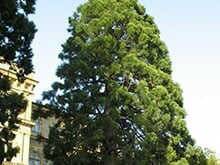
Sequoiadendron giganteum
Giant Sequoia
– This sentinel of a tree grows in a distinctive conical shape and offers rich red bark and deep green graceful branches. It is a very long-lived tree that matures at a height of 60-275’ tall x 25-60’ wide. Prefers full sun. Hardy in USDA zones 6-8.

Sequoiadendron giganteum
'Pendulum'
Weeping Giant Sequoia
– This unique conifer grows in an upright then weeping slightly horizontal form with draping deep blue-green foliage. Matures at 25’ tall x 3-4’ wide. Prefers full sun. Hardy in USDA zones 6-9.
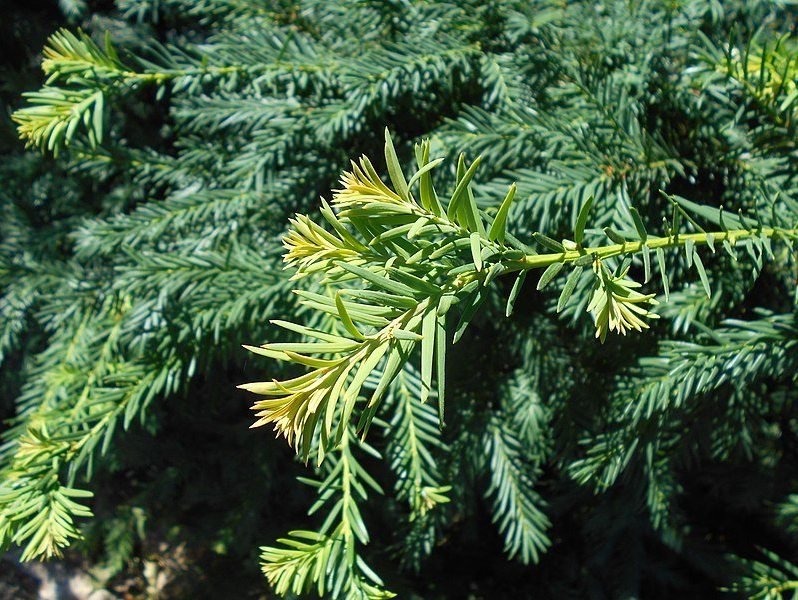
Taxus baccata
'Repandens'
Repandens Yew
– This low-growing yew has arching branches. It can be pruned into a hedge or allowed to adopt its more natural relaxed habit. It has dark green needles and red berries. Matures at 4’ tall x 10’ wide. Tolerant of full sun to shade. Hardy in USDA zones 5-9.
Taxus baccata
‘Summergold’
Summergold Yew
– This conifer has a spreading and weeping habit. The needles are eye-catching brilliant gold. Plant in well-drained soil. Matures at 1’ X 6’ wide. Prefers full sun to partial shade. Hardy to USDA zone 6.

Taxus cuspidata
'Dwarf Bright Gold'
Dwarf Bright Gold Yew
– This conifer has a shrubby, upright-spreading, mound-like habit. It has golden-green needles that are brighter in full sun and predominantly green in the lower light. Matures at 4-6’ tall x 5-7’ wide. Tolerant of full sun to part shade. Hardy in USDA zones 4-7.
Taxus cuspidata
'Nana Aurescens'
Nana Aurescens Yew
– This dwarf golden yew has a low mounding habit with bright golden-green needles. Matures at 2-3’ tall x 3-6’ wide. Tolerant of full sun to part shade. Hardy in USDA zones 4-7.
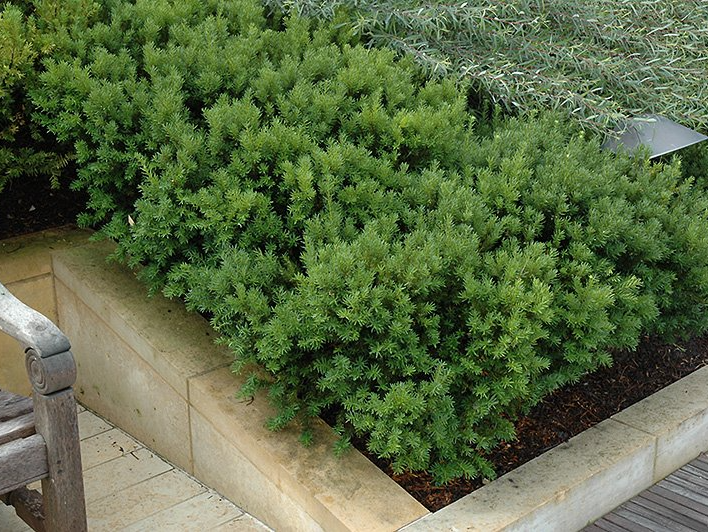
Taxus x media
‘Dark Green Spreader’
Dark Green Spreader Yew
– This dense shrub with a prostrate habit of growth. Rich dark green needles, wide-spreading and takes pruning very well. Matures 3-4‘tall x 4– 6’ wide. Prefers full to partial sun. Hardy to USDA zone 4.
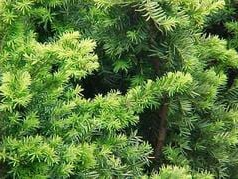
Taxus x media
‘Densiformis’
Densiformis Yew
– This is a semi-dwarf, dense and spreading conifer. Maturing at 3-4' tall x 5-7' wide. Prefers full sun to shadier locations. Hardy to USDA zone 4.
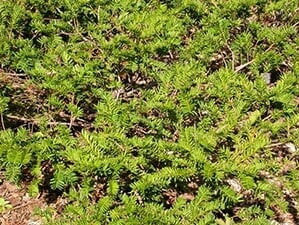
Taxus x media
'Everlow'
Everlow Yew
– This dwarf yew has a low growing spreading habit. It matures at 1-1 ½’ tall x 4-5’ wide. Prefers full sun to partial shade. Hardy in USDA zones 4-7.
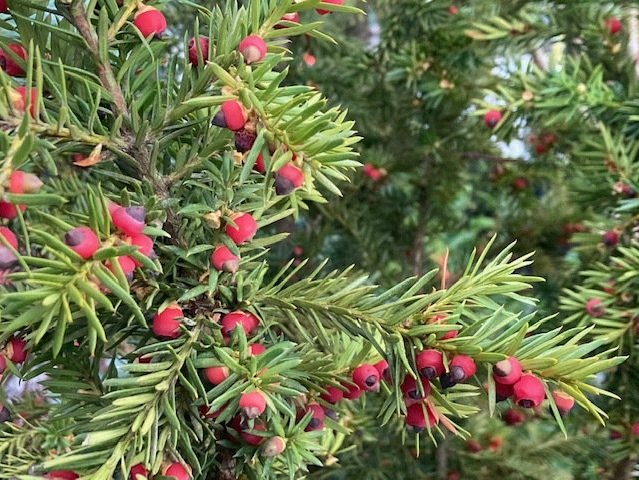
Taxus x media
'H.M. Eddie'
H.M. Eddie Yew
– This tall yew is an ideal for privacy screening. It has deep green needles and matures at 18-20’ tall x 3-5’ wide. Prefers full sun to partial shade. Hardy in USDA zones 4-7.
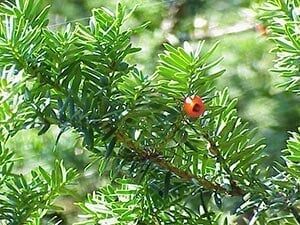
Taxus x media
'Hicksii'
Hicks Yew
– This yew variety has deep green needles and a dense, narrowly columnar habit. Matures at 12-20’ tall x 8-12 wide. Prefers full sun to partial shade. Hardy in USDA zones 4-7.

Taxus x media
'Viridis'
Viridis Yew
– A lush bright green dense conifer that grows in a columnar habit. It is ideal hedge material. Matures at 10’ tall x 2’ wide. Prefers full sun to partial shade. Hardy in USDA zones 5-7.
Thuja occidentalis
‘Anniek’
Sienna Sunset Arborvitae
– This compact conifer has a perfectly rounded shape. The golden foliage becomes tinged with reddish-bronze coloration in winter. Matures at 2’tall x 2’wide. Prefers full sun. Hardiness USDA zones 3-7.
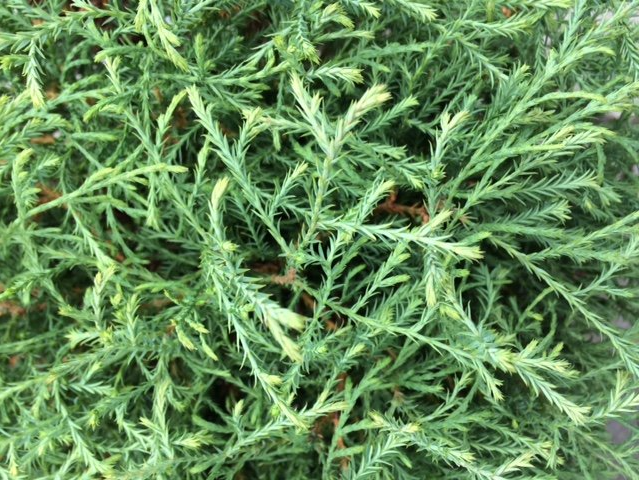
Thuja occidentalis
‘Bobazam’
Mr. Bowling Ball Arborvitae
– This dwarf, rounded shrub with dense dark foliage. It is a good choice for a low hedge or in foundation plantings. Matures at 2-3’ tall x wide. Prefers full sun. Hardiness USDA zones 3-8.
Thuja occidentalis
‘Congabe’
Fire Chief Arborvitae
– This globe-shaped conifer has fine, bright yellow spring that tinges deep red in fall. Reaches 2’ tall x wide in ten years. Prefers full sun. Hardiness USDA zones 5-8.
Thuja occidentalis
'Danica'
Danica Arborvitae
– This conifer is a slow-growing, dense shrub with a rounded form. It has medium to deep green foliage. Matures at 1-2’ tall x 1-2’ wide. Prefers full sun. Hardy in USDA zones 2-7.
Thuja occidentalis
'Filiformis'
Threadleaf Arborvitae
– This shrub-like conifer has a delicate draping weeping habit making it a unique feature tree for your landscape. Bearing medium green to light green branches. Matures at 7-8’ tall x 3-4’ wide. Prefers full sun. Hardy in USDA zones 4- 8.
Thuja occidentalis
‘Golden Tuffet’
Golden Tuffet Arborvitae
– This pillow-shaped conifer grows wider than tall, reminiscent of a cushion. It has a golden-orange color. Matures at 3’ tall x 4’ wide. Prefers full sun to part sun. Hardy to USDA zone 4.
Thuja occidentalis
'Hetz Midget'
Hetz Midget Arborvitae
– This cultivar is slow-growing and globe-shaped, and bears deep blue-green branches. Matures at 3-4’ tall and wide. Prefers full sun. Hardy in USDA zones 2-7.
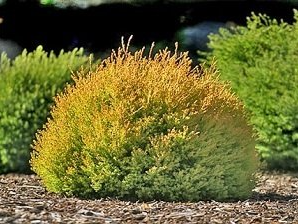
Thuja occidentalis
'Rheingold'
Rheingold Arborvitae
– This slow-growing, mound-shaped dwarf cultivar with golden foliage. Matures at 3-5’ tall x 3-5’ wide. Prefers full sun. Hardy in USDA zones 2-7.
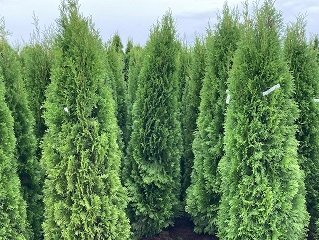
Thuja occidentalis
'Smaragd'
Emerald Green Arborvitae – A consistent performer in the landscape. Tight, pyramidal, evergreen spires work well as a hedge or to create a punctuation mark in the garden. It is popular because it retains its bright emerald green color throughout the year and has an attractive pattern to its branches. They have a naturally tight growing habit, so the only pruning required is to even up the top of the hedge. Thrive in full sun in fertile, well-drained soil with summer watering for the first few seasons. In these conditions, they grow 8 to 12 inches a year. A soaker hose and mulch are ideal for a new cedar hedge. Once established, cedars are drought tolerant. Set hedge plants 18 to 24 inches from center to center. Emerald Green cedars can reach 25 feet by 5 to 8 feet, but their growth slows dramatically at about 15 feet tall by 4 feet wide. Prefers full sun. Hardy in USDA zones 3-8.
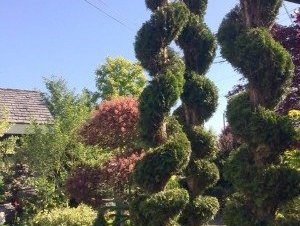
Thuja occidentalis
'Smaragd Spirals'
Emerald Green Arborvitae pruned into a spiral form
–Emerald Green cedars can reach 25 feet by 5 to 8 feet but their growth slows dramatically at about 15 feet tall by 4 feet wide. Prefers full sun. Hardy in USDA zones 3-8.
Thuja occidentalis
'Smaragd Topiary'
Emerald Greens Arborvitae pruned into a topiary form
– Emerald Green cedars can reach 25 feet by 5 to 8 feet but their growth slows dramatically at about 15 feet tall by 4 feet wide. Prefers full sun. Hardy in USDA zones 3-8.

Thuja occidentalis
‘Sunkist’
Sunkist Arborvitae
– This dense conical shaped conifer has brilliant golden foliage. Plant in well-drained soils. Prefers full sun to part shade. Matures at 6-10’ tall x 5-8’ wide. Hardy to USDA zone 2.
Thuja occidentalis
'Teddy'
Teddy Bear Arborvitae
– A charming and petite globe-shaped dwarf arborvitae with finely textured foliage. The Blue-green foliage can age to a bronze in winter. Prefers full sun. Matures at 1’ tall x 2’ wide. Hardy to USDA zone 3.
Thuja occidentalis
‘Tiny Tim’
Tiny Tim Arborvitae
– This dwarf conifer has a rounded shape with a finely branched habit. Matures at 1' tall x 1.5'. Prefers full sun. Hardy in USDA zones 2-7.

Thuja occidentalis
‘Aurea Nana’
Dwarf Golden Arborvitae
– This compactly branched conifer grows in a shrub-like oval shape. The golden color turns bronze in winter. Prefers full to partial sun. Matures at 4-6’ tall x 3-5’ wide. Hardy to USDA zone 6.

Thuja occidentalis
‘Golden Tuffet’
Golden Tuffet Arborvitae
– This compact shrub has a dense, mounded shape. The new growth is yellow in spring, maturing to shades of golden-copper color. Matures at 1-3’ tall and wide. Prefers full to partial sun. Hardy to USDA zone 3.
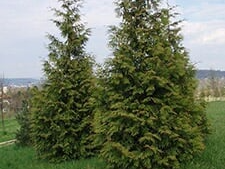
Thuja plicata
'Excelsa'
Excelsa Western Red Cedar
– This is a fast-growing conifer that is a great option for screening. It offers deep green long branches that can develop a copper cast through winter’s chill. Matures at 35’ tall x 20’ wide. Prefers full sun. Hardy to USDA zone 7.

Thuja plicata
‘4Ever Goldy’
4Ever Goldy Western Red Cedar
– This compact shrub grows quickly and offers a stunning display of gold-yellow foliage. Upright, drought-tolerant, evergreen shrub. Ht. 15-20’ tall x 3-4’ wide. Prefers full sun. Hardy to USDA zone 4.
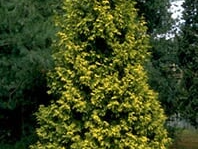
Thuja plicata
'Stoneham Gold'
Stoneham Gold Western Red Cedar
– This conifer is a dwarf form that is compact, upright, and bushy. It offers showy golden branch tips that age to a bronze-yellow. Prefers full sun to partial shade. Matures at 6’ tall x 6’ wide. Hardy to USDA zone 6.
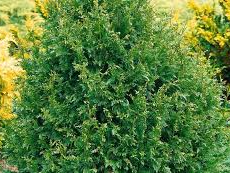
Thuja plicata
'Virescens'
Virescens Western Red Cedar
– This cultivar has medium green foliage and grows in a narrow pyramidal form with upright branches. A fast grower, growing up to 2’ in a year. Matures at 20-30’ tall x 9-12’ wide. Prefers full sun to partial shade. Hardy to USDA zone 5.
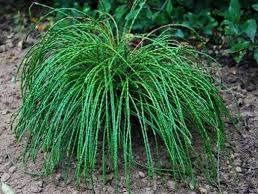
Thuja plicata
‘Whipcord’
Whipcord Cedar
– This mop-head-like plant has long, thick, glossy branches. Foliage is green in summer, the foliage turning to bronze in winter. Matures at 4’ tall and wide. Prefers full sun. Hardy to USDA zone 5.
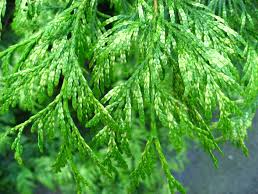
Thuja plicata
‘Zebrina’
Zebrina Arborvitae
– This variegated form of western red cedar produces feathery green foliage striped with creamy yellow. Matures at 30-50' tall x 8-12' wide. Prefers full sun. Hardy in USDA zones 5-7.

Thujopsis dolabrata
Hiba Cedar
– A slow-growing and refined conifer warranting more use. While similar to our western red cedar, it has bolder foliage that is glossy, deep forest green above, with beautiful, startling white markings beneath. Leaves are held in wide, flat branchlets and the overall effect is richly textural. Give it plenty of space to develop its uniform, pyramidal habit. Its texture is fine enough for a formal garden, but equally at place in the casual landscape. Grows best in bright shade in moist, well-drained soil and will also grow in full sun as long as the soil is moist and the summers not too hot. It is not heat or drought tolerant. It is slow-growing and reaches 10 to 15 feet tall by 4 to 6 feet wide in 10 years, maturing to 30 to 50 feet tall by 10 to 20 feet wide. Hardy in USDA zones 5-8.
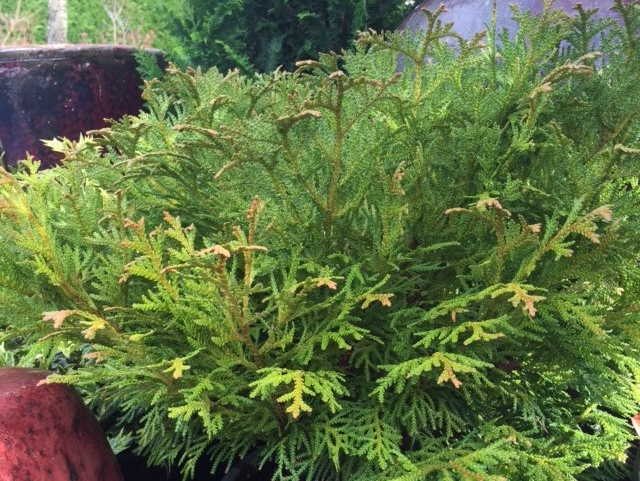
Thujopsis dolabrata
‘Nana’
Nana Hiba Cedar
– This compact, slow-growing conifer has thick textured leaves that are deep green on one side and creamy white on the other. Matures at 4’ tall x 6’ wide. Prefers full sun to shade. Hardy in USDA zones 5-9.
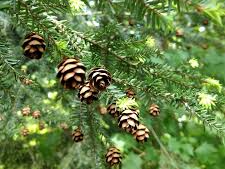
Tsuga canadensis
Eastern Hemlock
– A tall and elegant conifer it has small needles and delicate cones. Matures at 40-70’ tall x 25-35’ wide. Prefers full to partial sun. Hardy to USDA zone 4.
Tsuga canadensis
‘Geneva’
Geneva Eastern Hemlock
– This dwarf conical-shaped conifer has graceful draping branches and delicate small cones. It bears tiny medium green needles. Prefers full to partial sun. Matures at 8-15’ tall and wide. Hardy to USDA zone 4.
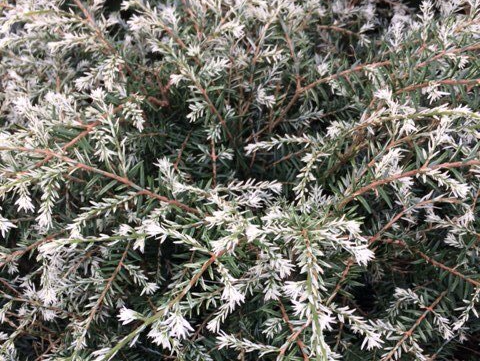
Tsuga canadensis
'Gentsch White'
Gentsch White Eastern Hemlock
– A dwarf conifer with needles at the branch tips that are silver-white. Prefers partial to full sun. Matures at to 3-4' tall and 4' wide. Hardy to USDA zone 3.
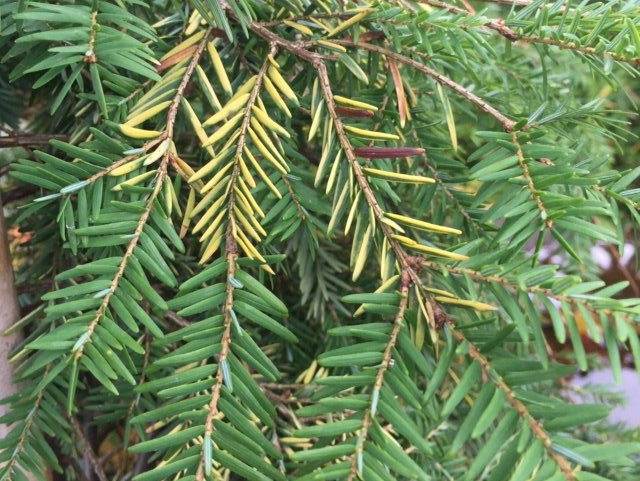
Tsuga canadensis
‘Golden Splendor’
Golden Splendor Eastern Hemlock
– Graceful golden foliage is featured on this conifer with dainty needles and cones. This cultivar tolerates full sun and produces a brighter color with more exposure. Matures at 25’ tall x 15’ wide. Prefers full sun. Hardy to USDA zone 4.
Tsuga canadensis
'Jeddeloh'
Jeddeloh Dwarf Canadian Hemlock
– This petite conifer has a mounded habit. Delicate, finely textured green needles are on pendulous branches. Matures at 2-3’ tall x 3-4’ wide. Prefers full shade to partial sun. Hardy to USDA zone 4.
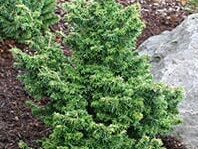
Tsuga canadensis
‘Jervis’
Jervis Canadian Hemlock
– This charming dwarf conifer has a pyramidal shape and dense deep green needles. Matures at 2-3’ tall x 3-5’ wide. Prefers full to partial sun. Hardy to USDA zone 4.
Tsuga canadensis
'Moon Frost'
Moon Frost Hemlock
– Bright white new growth is reminiscent of the glow of frost on a moonlit night. Older green inner foliage retains light tones giving the plant an overall whitish appearance. In winter, the white foliage is blushed with pink. This reliable dwarf conifer grows to 3 feet tall and 4 feet wide. Prefers partial sun to partial shade. Hardy in USDA zones 4 – 8.
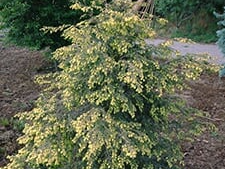
Tsuga canadensis
‘New Gold’
New Gold Eastern Hemlock
– This graceful conifer has gold new growth that makes a beautiful contrast to the previous year’s dark green needles. Matures at 12’ X 6’ in ten years. Prefers full to partial sun. Hardy to USDA zone 4.
Tsuga canadensis
'Pendula'
Pendula Hemlock
– When young it has a charming mounding habit as its branches reach outwards and droop elegantly at their tips. With age, it takes on a decidedly animated character, with increasing wingspan and variation in texture. The trick to this evergreen conifer is to give it plenty space to develop its characteristic and pleasing mature habit. Grows well in full sun as long as the soil is not dry. It also thrives in the dappled light under tall trees or with a half-day of sun, either morning or afternoon. Water plants regularly when they are young; they become drought tolerant once established. This conifer appreciates some organic content in the soil. With mature plants, consider thoughtful pruning of small side branches to reveal the extraordinary branching structure hidden beneath this shrub’s dense canopy. Grows to 5 feet high by 8 feet wide in ten years. After several decades this slow-growing coniferous evergreen can reach 10 to 15 feet tall and twice as wide. Prefers full sun. Hardy in USDA zone 3-8.
Tsuga canadensis
‘Summer Snow’
Summer Snow Hemlock
– The spring growth is white, providing a striking contrast to the dark interior foliage. The habit is upright and broad. Matures at 10’ tall x 8’ wide. Prefers partial sun to shade. Hardy to USDA zone 4.
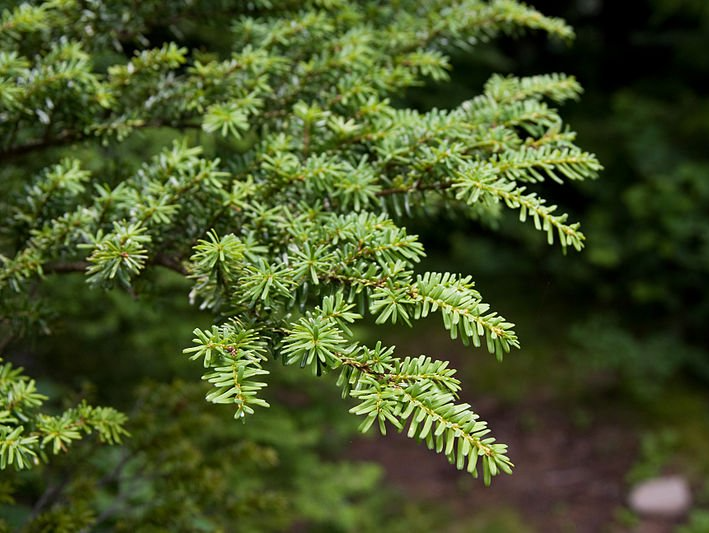
Tsuga diversifolia
Japanese Hemlock
– One of the Northwest’s most beautiful native evergreens. It develops into a slender small tree with gracefully layered side branches. It is excellent for creating an alpine look in the landscape. Plant in full sun to part shade in well-drained soil. Drought tolerant once established. It forms a slow-growing narrow tapered tree that will grow 8-10 feet tall and 4-6 feet wide in 10 years reaching a mature size of 20 feet tall and 6-8 feet wide in 30 years, grows well in containers. Hardy in USDA zones 4-8.
Tsuga heterophylla
'Thorsen's Weeping'
Thorsen's Weeping Hemlock
– This rich green conifer has a weeping habit with delicate needles and cones. Matures at 3-6’ tall in ten years and approximately equal width. Prefers full to partial sun. Hardy to USDA zone 5.
Tsuga sieboldii
'Greenball'
Greenball Northern Japanese Hemlock
– This petite, mounding dwarf conifer has short dark green needles. Matures at 2.5' tall x 2.5' wide in 10 years. Prefers full to part shade. Hardy to USDA zone 5.
x Cupressocyparis leylandii
Leyland Cypress – The growth rate is truly amazing and it can be pruned to maintain a certain shape. Excellent for quick screens, groupings, hedges. Fast-growing - easily grows 3 feet per year reaching 20 feet, then slows maturing at 60 feet tall and 8-15 feet wide. Prefers full sun. Hardy to USDA zone 6.
x Cupressocyparis leylandii
'Gold Rider'
Gold Rider Leyland Cypress
– This cultivar forms a columnar to pyramidal form bearing scale-like flat sprays which are yellow-gold at the tips, with a lime-green interior. This species is considered to be hardy under most site and soil conditions. After 10 years it may attain a height of 10 feet. Maturing at a height of 35 feet and a width of 15 feet. Best color in full sun. Hardy in USDA zones 5-9.
11910 Springhetti Road Snohomish, WA 98296 | Mon-Sat: 9am - 5pm | Sunday: 10am - 5pm
Phone: (360) 862-1323 | Fax: (360) 568-6803
Content, including images, displayed on this website is protected by copyright laws. Downloading, republication, retransmission or reproduction of content on this website is strictly prohibited. Terms of Use
| Privacy Policy


